Alpine IDA-X300, IDA-X200 User Manual

R |
Digital Media Receiver
EN
iDA-X200
Digital Media Receiver
iDA-X300
FR
ES
• OWNER’S MANUAL
Please read before using this equipment.
• MODE D’EMPLOI
Veuillez lire avant d’utiliser cet appareil.
• MANUAL DE OPERACIÓN
Léalo antes de utilizar este equipo.
ALPINE ELECTRONICS MARKETING, INC. |
ALPINE ELECTRONICS OF AUSTRALIA PTY. LTD. |
ALPINE ITALIA S.p.A. |
|
1-1-8 Nishi Gotanda, |
161-165 Princes Highway, Hallam |
Viale C. Colombo 8, 20090 Trezzano |
|
Shinagawa-ku, |
Victoria 3803, Australia |
Sul Naviglio (MI), Italy |
|
Tokyo 141-0031, Japan |
Phone 03-8787-1200 |
Phone 02-484781 |
|
Phone 03-5496-8231 |
ALPINE ELECTRONICS GmbH |
ALPINE ELECTRONICS DE ESPAÑA, S.A. |
|
ALPINE ELECTRONICS OF AMERICA, INC. |
|||
Frankfurter Ring 117, 80807 München, Germany |
Portal de Gamarra 36, Pabellón, 32 |
||
19145 Gramercy Place, Torrance, |
Phone 089-32 42 640 |
01013 Vitoria (Alava)-APDO 133, Spain |
|
California 90501, U.S.A. |
ALPINE ELECTRONICS OF U.K. LTD. |
Phone 945-283588 |
|
Phone 1-800-ALPINE-1 (1-800-257-4631) |
ALPINE ELECTRONICS (BENELUX) GmbH |
||
ALPINE ELECTRONICS OF CANADA, INC. |
Alpine House |
||
Fletchamstead Highway, Coventry CV4 9TW, U.K. |
Leuvensesteenweg 510-B6, |
||
777 Supertest Road, Toronto, |
Phone 0870-33 33 763 |
1930 Zaventem, Belgium |
|
Ontario M3J 2M9, Canada |
ALPINE ELECTRONICS FRANCE S.A.R.L. |
Phone 02-725-13 15 |
|
Phone 1-800-ALPINE-1 (1-800-257-4631) |
|
||
|
(RCS PONTOISE B 338 101 280) |
|
|
|
98, Rue de la Belle Etoile, Z.I. Paris Nord Il, |
|
|
|
B.P. 50016, 95945 Roissy Charles de Gaulle |
|
|
|
Cedex, France |
|
|
|
Phone 01-48638989 |
|
|
|
|
Designed by ALPINE Japan |
|
|
|
68-09359Z63-A |

ENGLISH
Contents
Operating Instructions
WARNING |
|
WARNING ................................................. |
4 |
CAUTION .................................................. |
4 |
PRECAUTIONS ........................................ |
4 |
Double Action Encoder Operation |
|
(iDA-X200 only) |
|
Getting Started |
|
Accessory List .................................................. |
7 |
Turning Power On and Off ............................... |
7 |
Detaching and Attaching the Front Panel ........ |
7 |
Initial System Start-Up ..................................... |
7 |
Adjusting Volume ............................................. |
7 |
Setting the Calendar ......................................... |
8 |
Setting the Time ............................................... |
8 |
Displaying the Calendar/Time .......................... |
8 |
Radio |
|
Listening to Radio ............................................ |
9 |
Presetting Stations Manually ............................ |
9 |
Presetting Stations Automatically .................... |
9 |
Tuning to Preset Stations .................................. |
9 |
Frequency Search Function ............................ |
10 |
Receiving a Multicast Station |
|
(HD Radio mode only) ............................... |
10 |
Changing the Display |
|
(HD Radio mode only) ............................... |
10 |
iPod® (Optional) |
|
Playback ......................................................... |
11 |
Searching for a desired Song/Title ................. |
11 |
Percent Skip Function .................................... |
12 |
Alphabet Skip Function (Only when |
|
iDA-X200 is connected via USB) ............... |
12 |
Up/Down Function ......................................... |
13 |
Search Position Memory ................................ |
13 |
Random Play Shuffle ...................................... |
13 |
Random Play Shuffle All ................................ |
13 |
Repeat Play ..................................................... |
13 |
Changing the Display ..................................... |
13 |
USB memory/Portable audio player |
|
(iDA-X200 only)/Changer (Optional) |
|
BANK Function (USB memory) .................... |
14 |
Playback .......................................................... |
14 |
Selecting a Disc (Changer) (Optional) ........... |
14 |
Multi-Changer Selection (Optional) ............... |
15 |
Repeat Play ..................................................... |
15 |
M.I.X. (Random Play) .................................... |
15 |
Searching for CD Track Number |
|
(CD changer only) ....................................... |
15 |
Searching for a desired Song (USB memory/ |
|
Portable audio player (iDA-X200 only)) ..... |
16 |
File/Folder Name Search (MP3 Changer) ...... |
16 |
Switching between Quick Search mode and |
|
Folder up/down mode (MP3 changer) |
|
(iDA-X300 only) ......................................... |
17 |
Quick Search (changer) .................................. |
17 |
Select the desired Folder (Folder up/down) |
|
(MP3/WMA/AAC) ...................................... |
17 |
Changing the Display ..................................... |
17 |
About MP3/WMA/AAC ................................. |
18 |
Sound Setting |
|
Adjusting Subwoofer/Bass/Treble/Balance |
|
(Between Left and Right)/Fader (Between |
|
Front and Rear)/Loudness/Defeat ............... |
19 |
Turning Subwoofer ON/OFF .......................... |
20 |
Setting the Subwoofer System ........................ |
20 |
Setting the Bass Control ................................. |
20 |
Setting the Treble Control ............................... |
21 |
Adjusting the High Pass Filter ........................ |
21 |
Operating the External Audio Processor ........ |
21 |
SETUP |
|
Bluetooth Setting |
|
Setting the Bluetooth Connection .................... |
22 |
1-EN

Audio Setting (Only when external audio processor is connected)
Operating the External Audio Processor |
|
(USER PRESET) ......................................... |
23 |
Turning Media Xpander ON/OFF .................... |
23 |
Setting the MX Level ....................................... |
23 |
Subwoofer On and Off ..................................... |
23 |
General Setting |
|
Setting of Calendar Display Pattern Switching |
|
(CALENDAR) ............................................. |
23 |
Setting the Clock Display (CLK MODE) ........ |
23 |
Connecting an MP3 Changer |
|
(PLAY MODE) ............................................ |
23 |
Sound (Beep) Guide Function |
|
(iDA-X200 only) .......................................... |
23 |
Turning Mute Mode On/Off (INT MUTE) ...... |
23 |
Setting the AUX+ Mode .................................. |
23 |
Setting the AUX+ NAME Mode ...................... |
24 |
Setting the AUX Mode (V-Link) ..................... |
24 |
Setting the Changer Name ............................... |
24 |
Setting the External Digital Input |
|
(DIGITAL AUX) .......................................... |
24 |
Setting the AUX+ Level (AUX IN GAIN) ...... |
24 |
Connecting to an External Amplifier |
|
(POWER IC) ................................................ |
24 |
Demonstration .................................................. |
24 |
Display Setting |
|
Dimmer Control ............................................... |
24 |
Scroll Type Setting ........................................... |
24 |
Scroll Setting (TEXT SCROLL) ...................... |
25 |
iPod Setting |
|
iPod Search Mode Setting ................................ |
25 |
TUNER Setting (Only when HD/SAT receiver is connected)
HD Radio Station Call Setting ......................... |
25 |
Digital Seek On/Off Setting ............................. |
25 |
SAT Radio Receiver (Optional) |
|
Receiving Channels with the SAT Radio |
|
Receiver (Optional) ..................................... |
25 |
Checking the SAT Radio ID Number ............. |
26 |
Storing Channel Presets .................................. |
26 |
Receiving Stored Channels ............................. |
26 |
Storing the desired Sports Team |
|
(SIRIUS only) ............................................. |
26 |
Storing the desired Song / Artist |
|
(SIRIUS only) ............................................. |
27 |
Recalling the stored information |
|
(SIRIUS only) ............................................. |
27 |
Canceling the stored Alert Memory |
|
(SIRIUS only) ............................................. |
27 |
Search Function .............................................. |
28 |
Switching between Quick Search mode and |
|
Category up/down mode |
|
(iDA-X300 only) .......................................... |
28 |
Quick Search Function .................................... |
28 |
Select the desired CATEGORY |
|
(Category up/down) ..................................... |
28 |
Receiving Weather or Traffic Information from |
|
SAT Radio .................................................... |
29 |
Instant Replay Function (SIRIUS only) .......... |
29 |
Changing the Display ...................................... |
29 |
Setting the Auxiliary Data Field Display |
|
(XM only) .................................................... |
30 |
IMPRINT Operation (Optional) |
|
(iDA-X200 only) |
|
Changing MultEQ mode ................................. |
30 |
Adjusting Sound Setting in Manual Mode ...... |
31 |
USER PRESET............................................. |
31 |
Storing the Audio Adjustment Level ............... |
31 |
Recalling the Audio Adjustment Level ............ |
31 |
Turning Media Xpander ON/OFF ................ |
31 |
Equalizer Presets (Factory’s EQ) |
|
(FR-EQ)..................................................... |
31 |
Sound Field Adjustment ............................... |
32 |
Adjusting the Parametric Equalizer Curve ....... |
32 |
Adjusting the Graphic Equalizer Curve ........... |
32 |
Adjusting the Time Correction ......................... |
32 |
Adjusting the Crossover Settings |
|
(X-OVER) .................................................... |
33 |
Turning Subwoofer ON/OFF........................ |
34 |
Setting the Subwoofer System...................... |
34 |
Setting the Subwoofer Phase ........................ |
34 |
Setting the Subwoofer Channel |
|
(SUBW CHANNEL)................................. |
34 |
Setting the Response Slope for the High |
|
Range Speaker (TW Setup)....................... |
34 |
Setting EQ mode........................................... |
34 |
Setting the Filter type.................................... |
34 |
Setting the Time Correction Unit |
|
(TCR Parameter) ....................................... |
34 |
Setting the MX Level.................................... |
34 |
About Time Correction ................................... |
35 |
About the Crossover ........................................ |
36 |
About IMPRINT ............................................. |
37 |
Information |
|
In Case of Difficulty ........................................ |
38 |
Specifications .................................................. |
41 |
2-EN

ENGLISH
Installation and |
|
Connections |
|
Warning .................................................. |
42 |
Caution ................................................... |
42 |
Precautions ............................................ |
42 |
Installation ...................................................... |
43 |
Connections .................................................... |
45 |
LIMITED WARRANTY
3-EN
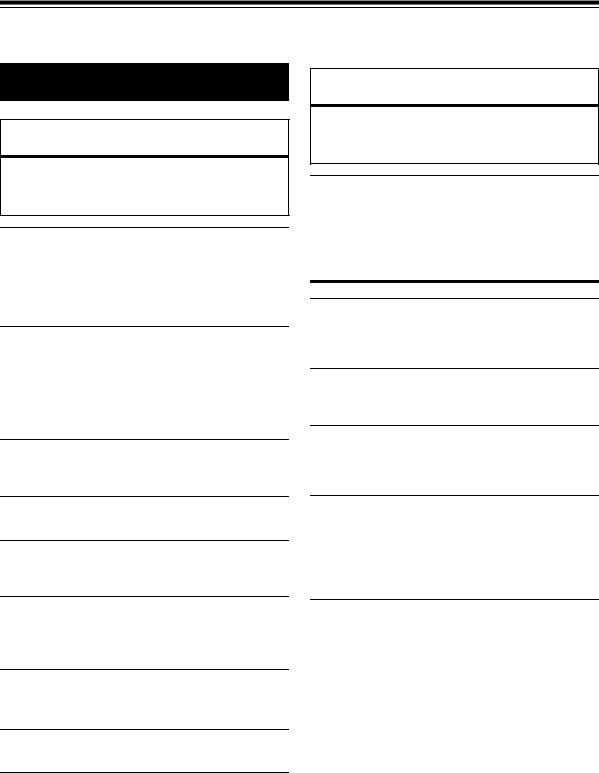
Operating Instructions
WARNING
 WARNING
WARNING
This symbol means important instructions. Failure to heed them can result in serious injury or death.
DO NOT OPERATE ANY FUNCTION THAT TAKES YOUR ATTENTION AWAY FROM SAFELY DRIVING YOUR VEHICLE.
Any function that requires your prolonged attention should only be performed after coming to a complete stop. Always stop the vehicle in a safe location before performing these functions. Failure to do so may result in an accident.
KEEP THE VOLUME AT A LEVEL WHERE YOU CAN STILL HEAR OUTSIDE NOISES WHILE DRIVING.
Excessive volume levels that obscure sounds such as emergency vehicle sirens or road warning signals (train crossings, etc.) can be dangerous and may result in an accident. LISTENING AT LOUD VOLUME LEVELS IN A CAR MAY ALSO CAUSE HEARING DAMAGE.
 CAUTION
CAUTION
This symbol means important instructions. Failure to heed them can result in injury or material property damage.
HALT USE IMMEDIATELY IF A PROBLEM APPEARS.
Failure to do so may cause personal injury or damage to the product. Return it to your authorized Alpine dealer or the nearest Alpine Service Center for repairing.
 PRECAUTIONS
PRECAUTIONS
Product Cleaning
Use a soft dry cloth for periodic cleaning of the product. For more severe stains, please dampen the cloth with water only. Anything else has the chance of dissolving the paint or damaging the plastic.
Temperature
Be sure the temperature inside the vehicle is between +60°C (+140°F) and –10°C (+14°F) before turning your unit on.
MINIMIZE DISPLAY VIEWING WHILE DRIVING.
Viewing the display may distract the driver from looking ahead of the vehicle and cause an accident.
Maintenance
If you have problems, do not attempt to repair the unit yourself. Return it to your Alpine dealer or the nearest Alpine Service Station for servicing.
DO NOT DISASSEMBLE OR ALTER.
Doing so may result in an accident, fire or electric shock.
USE ONLY IN CARS WITH A 12 VOLT NEGATIVE GROUND.
(Check with your dealer if you are not sure.) Failure to do so may result in fire, etc.
KEEP SMALL OBJECTS SUCH AS BOLTS OR SCREWS OUT OF THE REACH OF CHILDREN.
Swallowing them may result in serious injury. If swallowed, consult a physician immediately.
USE THE CORRECT AMPERE RATING WHEN REPLACING FUSES.
Failure to do so may result in fire or electric shock.
DO NOT BLOCK VENTS OR RADIATOR PANELS.
Doing so may cause heat to build up inside and may result in fire.
USE THIS PRODUCT FOR MOBILE 12V APPLICATIONS.
Use for other than its designed application may result in fire, electric shock or other injury.
Installation Location
Make sure this unit will not be installed in a location subjected to:
•Direct sun and heat
•High humidity and water
•Excessive dust
•Excessive vibrations
Protecting the USB connector
•Only a USB memory, iPod (iDA-X200 only) or Portable audio player (iDA-X200 only) can be connected to the USB connector on this unit. Correct performance using other USB products cannot be guaranteed.
•If the USB connector is used, be sure to connect it to the unit by using a USB extension cable (iDA-X200 supplied/iDA-X300 sold separately). A USB hub is not supported.
•Depending on the connected USB memory device, the unit may not function or some functions may not be performed.
•The audio file format that can be played back on the unit is MP3/ WMA/AAC.
•Artist/song name, etc., can be displayed, however characters may not be correctly displayed.
4-EN

 CAUTION
CAUTION
Alpine accepts no responsibility for lost data, etc., even if data, etc., is lost while using this product.
On Handling USB Memory
•To prevent malfunction or damage, note the following points. Read the USB memory Owner’s Manual thoroughly.
Do not touch the terminals by hand or metal. Do not subject USB memory to excessive shock.
Do not bend, drop, disassemble, modify or soak in the water.
•Avoid usage or storage in the following locations:
Anywhere in the car exposed to direct sunlight or high temperatures.
Anywhere the possibility of high humidity or corrosive substances are present.
•Fix the USB memory in a location where driver operation will not be hindered.
•USB memory may not function correctly at high or low temperature.
•Use only certified USB memory. Note that even certified USB memory, may not function correctly depending on its type or state.
•USB memory function is not guaranteed. Use USB memory according to the terms of agreement.
•Depending on the settings of the USB memory type, memory state or encoding software, the unit may not play back or display properly.
•A file that is copy-protected (copyright protection) cannot be played back.
•USB memory may take time to start playback. If there is a particular file other than audio in the USB memory, it may take considerable time before the file is played back or searched.
•The unit can play back “mp3,” “wma” or “m4a” file extensions.
•Do not add the above extensions to a file other than audio data. This non-audio data will not be recognized. The resulting playback may contain noise that can damage speakers and/or amplifiers.
•It is recommended to back up important data on a personal computer.
•Do not remove the USB device while playback is in progress. Change SOURCE to something other than USB, then remove the USB device to prevent possible damage to its memory.
•If the Portable audio player has an MSC/MTP setting, set to MTP.
•A Portable audio player in which data is stored by USB Mass Storage may not be playable on the unit.
•Depending on the Portable audio player settings, USB Mass Storage may be supported. For setting, refer to the Owner's Manual of the player.
•The unit can play back MP3/WMA files synchronized by Windows Media Player (Ver. 7.1, 8, 9, 9.1, 9.2), and are then forwarded to the player. The “mp3” or “wma” extensions are playable.
•If data is not synchronized by Windows Media Player and is forwarded in another way, the unit may not be able to correctly play back the files.
•WMDRM10 is supported by the unit.
•A file that is copy-protected (copyright protection) cannot be played back.
•It is recommended to back up important data on a personal computer.
•Do not remove the USB device while playback is in progress. Change SOURCE to something other than USB, then remove the USB device to prevent possible damage to its memory.
•Windows Media and the Windows logo are trademarks, or registered trademarks of Microsoft Corporation in the United States and/or other countries.
•iPod is a trademark of Apple Inc., registered in the U.S. and other countries.
•HD Radio™ and the HD Radio Ready logo are proprietary trademarks of iBiquity Digital Corp.
•“MPEG Layer-3 audio coding technology licensed from Fraunhofer IIS and Thomson.”
•“Supply of this product only conveys a license for private, noncommercial use and does not convey a license nor imply any right to use this product in any commercial (i.e. revenuegeneration) real time broadcasting (terrestrial, satellite, cable and/or any other media), broadcasting/streaming via internet, intranets and/or other networks or in other electronic content distribution systems, such as pay-audio or audio-on-demand applications. An independent license for such use is required. For details, please visit http://www.mp3licensing.com”
•Manufactured under license from Audyssey Laboratories MultEQ XT is a trademark of Audyssey Laboratories.
On Handling Portable audio player (iDA-X200 only)
•The unit can control a Portable audio player with the USB interface. Playable audio file formats are MP3 and WMA.
•Portable audio player function is not guaranteed. Use Portable audio player according to the terms of agreement. Read the Portable audio player Owner's Manual thoroughly.
•Avoid usage or storage in the following locations:
Anywhere in the car exposed to direct sunlight or high temperatures.
Anywhere the possibility of high humidity or corrosive substances are present.
•Fix the Portable audio player in a location where driver operation will not be hindered.
•Portable audio player may not function correctly at high or low temperature.
•Depending on the settings of the Portable audio player type, memory state or encoding software, the unit may not play back or display properly.
5-EN

Double Action Encoder Operation (iDA-X200 only)
Double Action encoder
There are 2 ways to operate the Double Action encoder.
Normal operation
Turn the Double Action encoder to the left or right.
The volume is adjusted, and an item is selected.
Useful operation
Turn the Double Action encoder to the left or right.
When you release the Double Action encoder, the display changes.
Double Action encoder
Push
Depending on the situation, you can change an item or display. If you press and turn the Double Action encoder to the left or right, you can change items/displays continuously.
6-EN
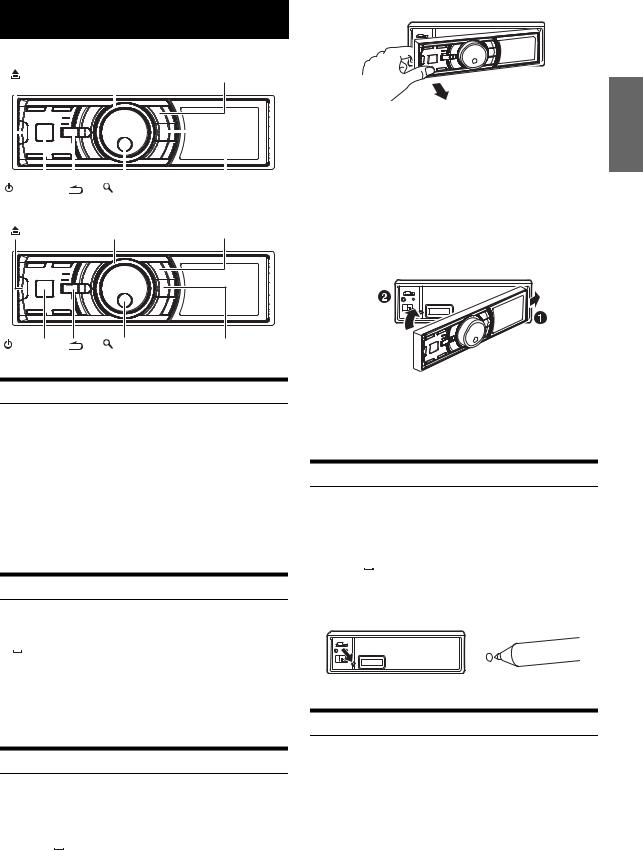
Getting Started
iDA-X200
Double Action encoder |
FUNC./SETUP |
|
|
|
|
|
|
|
|
|
|
|
|
|
|
|
|
|
|
|
|
|
|
|
|
|
|
|
|
|
|
|
|
|
|
|
|
|
|
|
|
|
|
|
|
|
|
SOURCE |
|
|
/ENTER |
VIEW |
||||
iDA-X300 |
|
|
|
|
|
|
||||
|
|
|
|
|
|
|||||
|
|
|
|
|
Rotary encoder |
FUNC./SETUP |
||||
|
SOURCE |
/ENTER |
VIEW |
|
Accessory List |
|
|
|
|
• |
Digital Media receiver........................................................ |
|
1 |
|
• |
Power cable ........................................................................ |
|
|
1 |
• FULL SPEEDTM Connection Cable |
|
|
||
|
(iDA-X300 only) .................................................................. |
|
|
1 |
• USB cable (iDA-X200 only)................................................ |
|
1 |
||
• iPod Dock interface cable (iDA-X200 only)...................... |
1 |
|||
• |
Mounting sleeve................................................................. |
|
|
1 |
• |
Carrying case..................................................................... |
|
|
1 |
• |
Bracket key......................................................................... |
|
|
2 |
• |
Screw (M5x8)...................................................................... |
|
|
4 |
• |
Owner’s Manual .......................................................... |
|
|
1 set |
Turning Power On and Off
Press  SOURCE to turn on the unit.
SOURCE to turn on the unit.
•The unit can be turned on by pressing any other button except
 (Release), Double Action encoder (iDA-X200 only) and VIEW. The unit is also automatically turned on if a USB memory is connected.
(Release), Double Action encoder (iDA-X200 only) and VIEW. The unit is also automatically turned on if a USB memory is connected.
Press and hold  SOURCE for at least 2 seconds to turn off the unit.
SOURCE for at least 2 seconds to turn off the unit.
• The first time power is turned on, the volume will start from level 12.
Detaching and Attaching the Front Panel
Detaching
1 Turn off the unit power.
2 Press  (Release) at the middle left side until the front panel pops out.
(Release) at the middle left side until the front panel pops out.
3 Grasp the left side of the front panel and pull it out.
•The front panel may become hot in normal usage (especially the connector terminals on the back of the front panel.) This is not a malfunction.
•To protect the front panel, place it in the supplied carrying case.
Attaching
1 Insert the right side of the front panel into the main unit. Align the groove on the front panel with the projections on the main unit.
2 Push the left side of the front panel until it locks firmly into the main unit.
•Before attaching the front panel, make sure that there is no dirt or dust on the connector terminals and no foreign object between the front panel and the main unit.
•Attach the front panel carefully. Hold the panel by its sides to avoid pushing any buttons by mistake.
Initial System Start-Up
Be sure to press the RESET switch when using the unit for the first time, after changing the car battery, etc.
1 Turn off the unit power.
2 Press  (Release) to remove the front panel.
(Release) to remove the front panel.
3 Press RESET with a ballpoint pen or similar pointed object.
Adjusting Volume
Turn the Double Action encoder (iDA-X200 only) or Rotary encoder (iDA-X300 only) until the desired sound is obtained.
7-EN
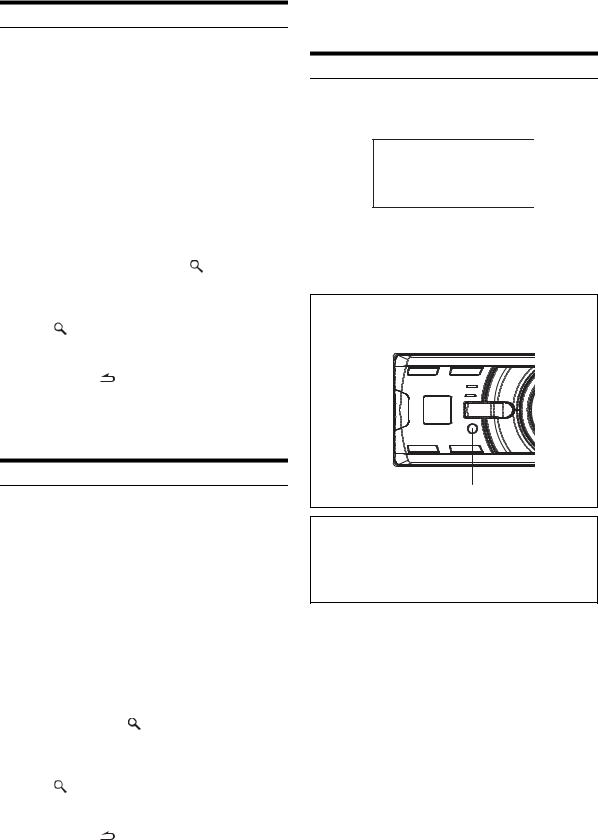
Setting the Calendar
1 Press and hold FUNC./SETUP for at least 2 seconds to activate the SETUP selection mode.
2 Turn the Double Action encoder (iDA-X200 only) or Rotary encoder (iDA-X300 only) to select the GENERAL mode, and then press  /ENTER.
/ENTER.
BT*1  AUDIO*2
AUDIO*2  GENERAL
GENERAL  DISPLAY
DISPLAY  IPOD
IPOD  TUNER*3
TUNER*3  BT
BT
*1 Displayed only when INT MUTE is set to OFF, and the mode is set to other than BT AUDIO.
*2 Displayed only when an external audio processor is connected. For details, refer to the Owner’s Manual of the external audio processor.
*3 Only when HD Radio / SAT Radio receiver is connected.
3 |
Turn the Double Action encoder (iDA-X200 only) |
|
|
or Rotary encoder (iDA-X300 only) to select |
|
|
CALENDAR ADJ, and then press /ENTER. |
|
4 |
Turn the Double Action encoder (iDA-X200 only) |
|
|
or Rotary encoder (iDA-X300 only) to set year. |
|
5 |
Press /ENTER. |
|
6 |
Repeat steps 4 and 5 above to set month, day. |
|
7 |
Press and hold |
for at least 2 seconds to return to |
|
normal mode. |
|
•Pressing  during the procedure will return to the previous mode.
during the procedure will return to the previous mode.
•If no operation is performed for 60 seconds, the unit will return to normal mode automatically.
Setting the Time
1 Press and hold FUNC./SETUP for at least 2 seconds to activate the SETUP selection mode.
2 Turn the Double Action encoder (iDA-X200 only) or Rotary encoder (iDA-X300 only) to select the GENERAL mode, and then press  /ENTER.
/ENTER.
BT*1  AUDIO*2
AUDIO*2  GENERAL
GENERAL  DISPLAY
DISPLAY  IPOD
IPOD  TUNER*3
TUNER*3  BT
BT
*1 Displayed only when INT MUTE is set to OFF, and the mode is set to other than BT AUDIO.
*2 Displayed only when an external audio processor is connected. For details, refer to the Owner’s Manual of the external audio processor.
*3 Only when HD Radio / SAT Radio receiver is connected.
3 |
Turn the Double Action encoder (iDA-X200 only) |
|
|
or Rotary encoder (iDA-X300 only) to select CLK |
|
|
ADJ, and then press /ENTER. |
|
4 |
Turn the Double Action encoder (iDA-X200 only) |
|
|
or Rotary encoder (iDA-X300 only) to set hour. |
|
5 |
Press /ENTER. |
|
6 |
Repeat steps 4 and 5 above to set minutes. |
|
7 |
Press and hold |
for at least 2 seconds to return to |
|
normal mode. |
|
8-EN
•Pressing  during the procedure will return to the previous mode.
during the procedure will return to the previous mode.
•If no operation is performed for 60 seconds, the unit will return to normal mode automatically.
Displaying the Calendar/Time
Press VIEW.
The calendar/time is displayed. Pressing VIEW again will return to normal mode.
0 7 / 1 2 / 3 1 12:00
•If an HD Radio Tuner is connected, text information can be displayed. Refer to “Changing the Display (HD Radio mode only)” (page 10).
•If an XM receiver is connected, the Auxiliary Data Field can be displayed. Refer to “Setting the Auxiliary Data Field Display (XM only)” (page 30).
Controllable With Remote Control
Point the optional remote control transmitter at the remote control sensor.
Remote control sensor
Connectable to Steering Remote Control Interface Box (iDA-X200 only)
You can operate this unit from the vehicle’s control unit when an Alpine Steering Remote Control Interface Box (optional) is connected. For details, contact your Alpine dealer.
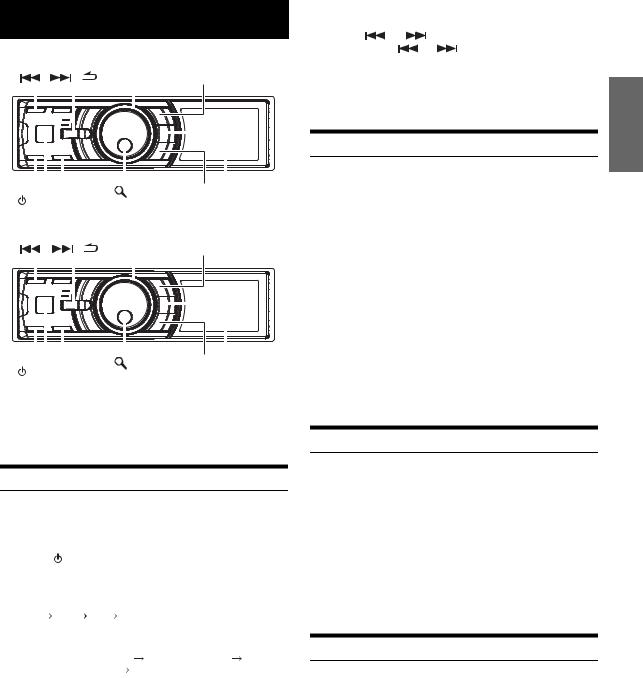
Radio
iDA-X200
Double Action
encoder FUNC./SETUP
|
|
|
|
|
|
|
|
|
|
|
|
|
|
|
|
|
|
|
|
|
|
|
|
|
|
|
|
|
|
|
|
|
|
|
|
|
|
|
|
|
|
|
|
|
|
|
|
|
|
|
|
|
|
|
|
|
|
|
|
BAND |
TUNE/A.ME |
/ENTER PRESET VIEW |
|||||||
SOURCE |
|
|
|
|
|||||
iDA-X300
Rotary encoder FUNC./SETUP
|
|
|
|
|
|
|
|
|
|
|
|
|
|
|
|
|
|
|
|
|
|
|
|
|
|
|
|
|
|
|
|
|
|
|
|
|
|
|
|
|
|
|
|
|
|
|
|
|
|
|
|
|
|
|
|
|
|
|
|
BAND |
TUNE/A.ME |
/ENTER PRESET VIEW |
|||||||
SOURCE |
|
|
|
|
|||||
This unit cannot receive HD Radio signals (digital terrestrial radio). In order to activate the digital radio functions described below, an optional HD Radio Tuner module must be connected through the Ai-NET bus.
Listening to Radio
HD Radio can be received if the HD Radio TUNER MODULE (TUA-T500HD) is connected. While receiving HD Radio, the unit can automatically switch between the analog and digital signal.
1 |
Press SOURCE to select TUNER mode. |
|
2 |
Press BAND repeatedly until the desired radio band |
|
|
is displayed. |
|
|
FM1 FM2 AM |
FM1 |
3 |
Press TUNE/A.ME to select the tuning mode. |
|
|
DX SEEK (Distance mode) SEEK (Local mode) |
|
|
(Blank) (Manual mode) |
DX SEEK (Distance mode) |
• The initial mode is Distance mode.
Distance mode:
Both strong and weak stations will be automatically tuned in (Automatic Seek Tuning).
Local mode:
Only strong stations will be automatically tuned in (Automatic Seek Tuning).
Manual mode:
The frequency is manually tuned in steps (Manual tuning).
4 Press |
or |
to tune in the desired station. |
|
Holding down |
or |
will change the frequency |
|
continuously. |
|
|
|
•If DIGITAL SEEK is set to ON, the SEEK UP/DOWN functions only stop on digital station frequencies while receiving HD radio. Refer to “Digital Seek On/Off Setting” (page 25).
Presetting Stations Manually
1 Select the radio band and tune in a desired radio station you wish to store in the preset memory.
2 Press PRESET.
The Preset screen is displayed.
3 Turn the Double Action encoder (iDA-X200 only) or Rotary encoder (iDA-X300 only) to select the preset number.
4 Press and hold  ENTER for at least 2 seconds.
ENTER for at least 2 seconds.
The selected station is stored.
The display shows the band, preset number and station frequency memorized.
•A total of 18 stations can be stored in the preset memory (6 stations for each band; FM1, FM2 and AM).
•If you store a station in a preset memory which already has a station, the current station will be cleared and replaced with the new station.
Presetting Stations Automatically
1 Press BAND repeatedly until the desired radio band is displayed.
2 Press and hold TUNE/A.ME for at least 2 seconds.
The tuner will automatically seek and store 6 strong stations in the selected band. They will be stored 1 to 6 in order of signal strength.
When the automatic memory has been completed, the tuner goes to the station stored in preset location No.1.
•If no stations are stored, the tuner will return to the original station you were listening to before the auto memory procedure began.
Tuning to Preset Stations
1 Press BAND repeatedly until the desired band is displayed.
2 Press PRESET.
The Preset screen is displayed.
3 Turn the Double Action encoder (iDA-X200 only) or Rotary encoder (iDA-X300 only) to select a radio station.
4 Press  ENTER.
ENTER.
The display shows the band, preset number and frequency of the station selected.
9-EN
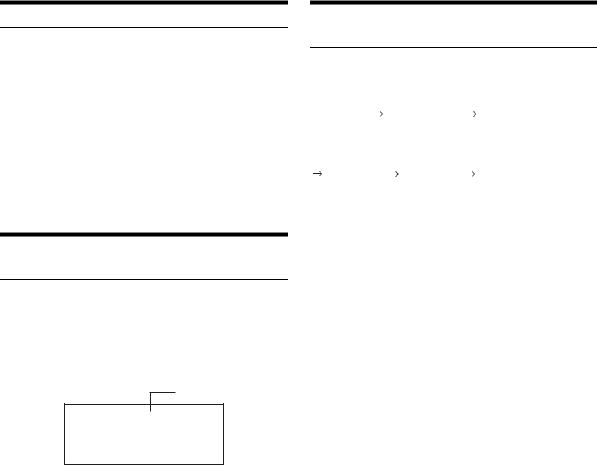
Frequency Search Function
You can search for a radio station by its frequency.
1 Press  /ENTER in Radio mode to activate Frequency search mode.
/ENTER in Radio mode to activate Frequency search mode.
2 Turn the Double Action encoder (iDA-X200 only) or Rotary encoder (iDA-X300 only) to select the desired frequency.
3* Press  /ENTER to receive the selected frequency.
/ENTER to receive the selected frequency.
* Operation is not required during HD Radio reception.
•Press  in the search mode to cancel. Or, the search mode will be canceled if no operation is performed for 10 seconds.
in the search mode to cancel. Or, the search mode will be canceled if no operation is performed for 10 seconds.
Receiving a Multicast Station (HD Radio mode only)
Multicasting which is the Ability to broadcast multiple program streams over a single FM frequency thereby increasing the amount and diversity of content choices. A maximum of eight multicast station channels can be selected on this unit.
1 When multicast station is received, the program number is displayed, and <A> indicator lights UP.
Program No.
FM1- 2
8 8 . 8
2 Press FUNC./SETUP to display the Program Type screen.
3 Turn the Double Action encoder (iDA-X200 only) or Rotary encoder (iDA-X300 only) to select a program, and press  /ENTER.
/ENTER.
The selected program is received.
|
|
|
|
Program No. |
|
|
|
|
|
||
|
|
|
|
|
|
|
|
|
|
|
|
|
FM1- 3 |
|
|
||
|
|
8 8 . 8 |
|
||
|
|
|
|
||
Program Service example: |
|
|
|||
Multicast Radio Station |
Program No. |
Program Service |
|||
88.8 |
|
1 |
|
MPS: Main Program Service |
|
88.8 |
|
2 |
|
SPS: Sub-program Service |
|
88.8 |
|
3 |
|
SPS: Sub-program Service |
|
|
|
· |
|
|
|
|
|
· |
|
|
|
|
|
· |
|
|
|
88.8 |
|
8 |
|
SPS: Sub-program Service |
|
10-EN
Changing the Display (HD Radio mode only)
Press VIEW.
Every time VIEW is pressed changes the display.
Band No. |
|
|
Station |
|
Song title |
||||
Frequency |
|
|
Station Call Letter* |
|
Artist title |
||||
|
|
|
|
|
|
|
|
|
|
|
|
|
|
|
|
|
|
|
|
|
Song title |
|
|
Calendar |
|
|
Band No. |
|
|
|
Album title |
|
|
Clock |
|
|
Frequency |
|
|
|
|
|
|
|
|
|
|
|
|
*You can set a long or short HD Radio station name. Refer to “HD Radio Station Call Setting” (page 25).
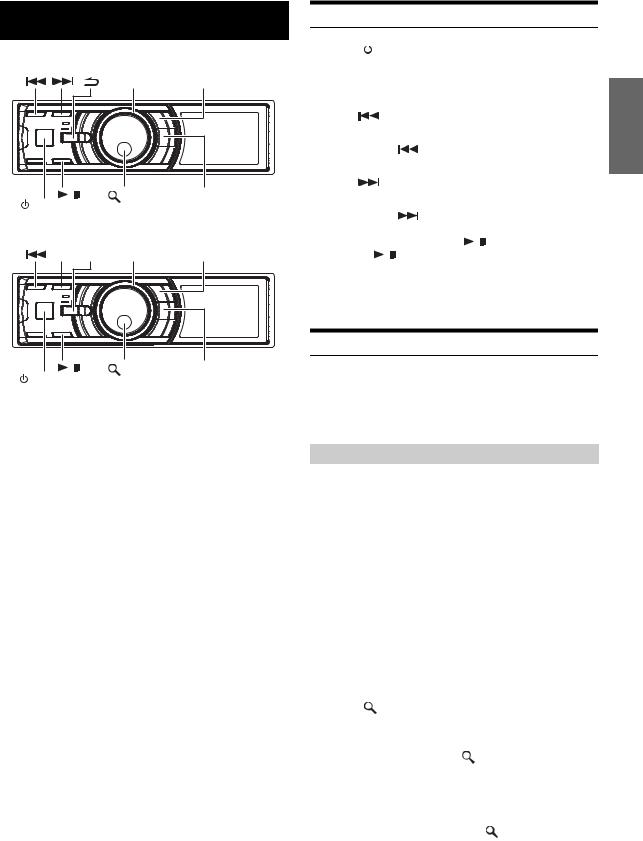
iPod® (Optional)
iDA-X200
Double Action
encoder FUNC./SETUP
 /
/  /ENTER VIEW
/ENTER VIEW
SOURCE
iDA-X300

 Rotary encoder FUNC./SETUP
Rotary encoder FUNC./SETUP
 /
/  /ENTER VIEW
/ENTER VIEW
SOURCE
An iPod® can be connected to this unit by using the proprietary ALPINE FULL SPEEDTM Connection Cable (KCE-422i) (iDA-X200 sold separately/iDA-X300 supplied) (or the iPod Dock interface cable (supplied, iDA-X200 only)). When this unit is connected by using the cable, the controls on the iPod are not functional.
•Only 5th generation iPod, first generation iPod nano and second generation iPod nano can be connected via a USB device (iDA-X200 only).
•Set AUX+ to OFF when an iPod is connected (refer to “Setting the AUX+ Mode” on page 23).
•If the Bluetooth Box and an iPod are connected at the same time, be sure to disconnect the iPod from the Bluetooth Box while turning ACC to OFF.
About iPods usable with this unit
•The unit can be used with the fourth generation and above iPod, iPod photo, iPod mini, the first generation iPod nano or the second generation iPod nano only. However, future generation iPod compatibility cannot be guaranteed.
•Touch wheel or scroll wheel type iPods without the dock connector cannot be connected to the unit.
•The unit can be used with the following iPod.
<USB connected> (iDA-X200 only)
Fifth generation iPod
First generation iPod nano Second generation iPod nano
<Directly connected>
Fourth generation iPod Fifth generation iPod iPod photo
iPod mini
First generation iPod nano Second generation iPod nano
•If the unit is used with iPod software versions of iTunes earlier than 7.1.0.59, correct function and performance are not guaranteed.
Playback
1 Press  SOURCE to switch to the IPOD or USB IPOD (iDA-X200 only) mode.
SOURCE to switch to the IPOD or USB IPOD (iDA-X200 only) mode.
2 Press or
or to select the desired song.
to select the desired song.
Return to the beginning of the current song:
Press .
Fast backward through current song:
Press and hold |
. |
Advance to the beginning of the next song:
Press .
Fast forward through current song:
Press and hold |
. |
3 To pause playback, press / . |
|
Pressing / |
again will resume playback. |
•If a song is playing on the iPod when it is connected to this unit, it will continue playing after the connection.
•An episode or audiobook may have several chapters, the chapter can be changed by pressing or
or .
.
Searching for a desired Song/Title
An iPod can contain hundreds of songs. By keeping these songs organized in playlists, this unit can use these to ease song searches.
Using the Playlist/Artist/Album/Podcast/Audiobook/Genre/Composer/ Song search mode’s individual hierarchy, you can narrow down your search as shown in the table below.
Hierarchy 1 |
Hierarchy 2 |
Hierarchy 3 |
Hierarchy 4 |
|
|
|
|
PLAYLISTS |
SONG |
— |
— |
|
|
|
|
ARTISTS* |
ALBUM* |
SONG |
— |
|
|
|
|
ALBUMS* |
SONG |
— |
— |
|
|
|
|
PODCASTS |
EPISODE |
— |
— |
|
|
|
|
AUDIOBOOKS |
— |
— |
— |
|
|
|
|
GENRES* |
ARTIST* |
ALBUM* |
SONG |
|
|
|
|
COMPOSERS* |
ALBUM* |
SONG |
— |
|
|
|
|
SONGS |
— |
— |
— |
|
|
|
|
•You can select your preferred search mode. Refer to “iPod Search Mode Setting” (page 25).
For example: Searching by Artist name
The following example explains how an ARTISTS search is performed. Another search mode can be used for the same operation, although the hierarchy differs.
1 |
Press /ENTER to activate the Menu Select mode. |
2 |
Turn the Double Action encoder (iDA-X200 only) |
|
or Rotary encoder (iDA-X300 only) to select the |
|
ARTISTS, and then press /ENTER. |
|
The artist search mode is activated and artists names are |
|
displayed. |
3 |
Turn the Double Action encoder (iDA-X200 only) |
|
or Rotary encoder (iDA-X300 only) to select the |
|
desired Artist, and then press /ENTER. |
The album search mode is activated and albums names are displayed.
11-EN

4 Turn the Double Action encoder (iDA-X200 only) or Rotary encoder (iDA-X300 only) to select an album, and then press  /ENTER.
/ENTER.
The song search mode is activated and songs names are displayed.
5 Turn the Double Action encoder (iDA-X200 only) or Rotary encoder (iDA-X300 only) to select a song and press  /ENTER.
/ENTER.
The selected song is played back.
•While in the search mode, if you press and hold  for at least 2 seconds the search mode is canceled.
for at least 2 seconds the search mode is canceled.
•In the search mode, pressing  will return to the previous mode.
will return to the previous mode.
•When search is made during M.I.X. play, the M.I.X. play mode will be canceled.
•“NO SONG” will be displayed if there are no songs in the selected playlist in the PLAYLISTS search mode.
•“NO PODCAST” will be displayed if there is no podcast data in the iPod in the PODCASTS search mode.
•“NO A-BOOK” will be displayed if there is no audiobook data in the iPod in AUDIOBOOKS search mode.
•If the iPod’s name is selected in the Playlist Search mode and
 /ENTER is pressed, all songs in the iPod are searchable. If you press and hold
/ENTER is pressed, all songs in the iPod are searchable. If you press and hold  /ENTER for at least 2 seconds, all songs in the iPod are played back beginning from the first song listed.
/ENTER for at least 2 seconds, all songs in the iPod are played back beginning from the first song listed.
•The display “NO SUPPORT” is scrolled if text information is not compatible with this unit.
•After selecting [ALL] in the search mode with “*”, press and hold
 /ENTER for at least 2 seconds to play back all songs in the iPod or selected search mode.
/ENTER for at least 2 seconds to play back all songs in the iPod or selected search mode.
•If percent skip function is activated in the search mode, a search can be made quickly by skipping to the specified location. For details, refer to “Percent Skip Function” on page 12.
•If Alphabet Skip Function is activated in the search mode, a search can be made quickly by Alphabet skip function to find the desired artist or song, etc. For details, refer to “Alphabet Skip Function (Only when iDA-X200 is connected via USB)”on page 12.
•In the search mode, you can scroll the page by pressing and turning the Double Action encoder. (iDA-X200 only.)
•If no operation is performed for 60 seconds, the unit will return to normal mode automatically.
Percent Skip Function
The unit is provided with a percent skip function for effective searching. When you use this function in the search mode, you can quickly search an artist or a song, etc.
If there are 100 songs in your iPod, they are divided into 10 groups using percentages (shown below).
Number of |
|
|
|
All 100 songs |
|
|
|
|
song |
|
|
|
|
|
|
||
|
|
|
|
|
|
|
|
|
|
10th |
20th |
... |
50th |
... |
80th |
... |
100th |
% |
song |
song |
|
song |
|
song |
|
song |
10 % |
|
|
|
|
|
|
|
|
20 % |
|
|
|
|
|
|
|
|
... |
|
|
|
|
|
|
|
|
50 % |
|
|
|
|
|
|
|
|
... |
|
|
|
|
|
|
|
|
80 % |
|
|
|
|
|
|
|
|
... |
|
|
|
|
|
|
|
|
100 % |
|
|
|
|
|
|
|
|
*You can select to show a percentage of the total stored songs, in 10% steps.
By using this function on iDA-X200
1 Press FUNC./SETUP repeatedly to choose the percent skip mode.
<When the unit is connected via USB>
Alphabet skip function  Percent skip function
Percent skip function  Normal search mode
Normal search mode  Alphabet skip function
Alphabet skip function
<When the unit is directly connected>
Percent skip function  Normal search mode
Normal search mode  Percent skip function
Percent skip function
2 Press and turn the Double Action encoder.
Each turn of the Double Action encoder to the right will jump 10%, 20% and 100% in ascending order.
Each turn of the Double Action encoder to the left will jump 100%, 90% and 10% in descending order.
Scroll bar display example (if 50% is shown)
scroll bar
By using this function on iDA-X300
1 Press FUNC./SETUP to activate the percent selection mode.
2 Turn the Rotary encoder to select a designated percent parameter, and then press  /ENTER.
/ENTER.
The percent skip function jumps to the following selected 10% 20%…50%…80%…100%
20%…50%…80%…100% 10%.
10%.
•The iDA-X300 is available only for the direct connection, and is not available for the USB connection.
Alphabet Skip Function (Only when iDA-X200 is connected via USB)
The initial skip function is skipped to the next number, symbol or letter such as from A to B, B to C.
You can skip in reverse order such as B to A by turning the Double Action encoder to the left.
1 Press FUNC./SETUP repeatedly to choose the alphabet skip mode.
Alphabet skip function Percent skip function
Percent skip function Normal search mode
Normal search mode Alphabet skip function
Alphabet skip function
2 Press and turn the Double Action encoder.
A list is skipped to the next page or next number, symbol or letter.
•If the Double Action encoder is pressed and turned to the left or right, the display continuously changes.
•The Alphabet Skip Function in the song search mode is available only when a song search is selected on the Menu select screen.
12-EN
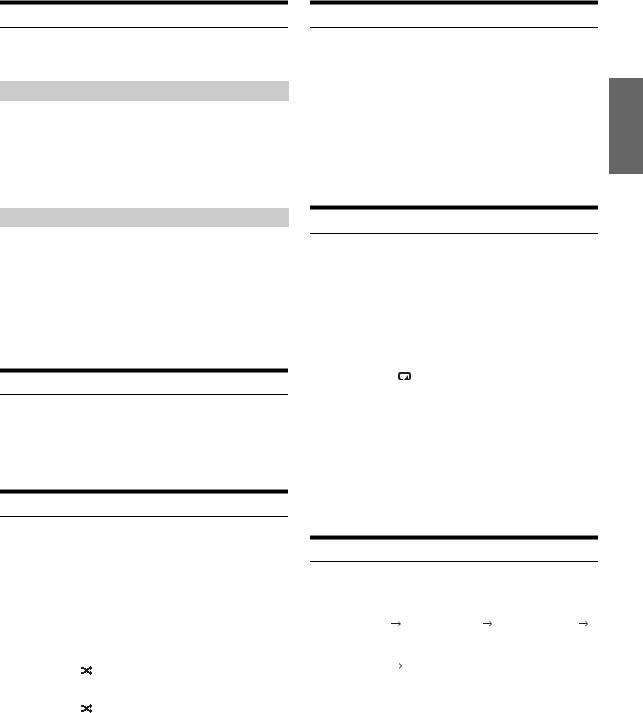
Up/Down Function
If you select an album and press and hold  /ENTER in the search mode, this album will be played back repeatedly. To go to the previous or next Album, use the Up/Down function.
/ENTER in the search mode, this album will be played back repeatedly. To go to the previous or next Album, use the Up/Down function.
By using this function on iDA-X200
Press and turn the Double Action encoder to the left.
Returns to the previous item.
Press and turn the Double Action encoder to the right.
Advances to the next item.
By using this function on iDA-X300
Press and hold  /ENTER for at least 2 seconds, then turn the Rotary encoder to select the desired Playlist/ Artist/Album/Genre/Composer.
/ENTER for at least 2 seconds, then turn the Rotary encoder to select the desired Playlist/ Artist/Album/Genre/Composer.
•If you do not perform a search or only search for a song name or audiobook, this function is not valid.
•During an artist search, albums for that artist can be played.
•If an album is selected during an artist search, the Up/Down function can be used to play other albums by that artist.
•This function is inactive during shuffle playback.
Search Position Memory
During iPod playback, you can quickly return to the last-selected hierarchy level in the search mode.
1 Press  .
.
The hierarchy you selected last in the search mode is displayed.
Random Play Shuffle
1 Press FUNC./SETUP.
2 Turn the Double Action encoder (iDA-X200 only) or Rotary encoder (iDA-X300 only) to select M I X, and press  /ENTER.
/ENTER.
The Shuffle mode is activated.
3 Turn the Double Action encoder (iDA-X200 only) or Rotary encoder (iDA-X300 only) to select the M I X (Shuffle) playback mode, and press  /ENTER.
/ENTER.
M I X ALBUM |
: An album in the iPod is selected at |
|
random, and is played back in the |
|
album song order. |
SONG |
: If you select a song in the search |
|
mode, all songs in the selected |
|
mode are played back at random. |
OFF |
: Shuffle mode off. |
4 Press FUNC./SETUP.
The songs will be played back in random sequence.
•If no operation is performed for 10 seconds, the unit will return to normal mode.
•To cancel, select OFF in the above procedure.
•Shuffle Album/Shuffle Song works the same way as iPod Shuffle Albums/Shuffle Songs.
Random Play Shuffle All
Shuffle ALL plays all songs in the iPod randomly.
1 Press  /ENTER.
/ENTER.
The Menu Select screen is displayed.
2 Press  /ENTER while selecting SHUFFLE ALL.
/ENTER while selecting SHUFFLE ALL.
The indicator 

 lights, and the songs will be played back in random sequence.
lights, and the songs will be played back in random sequence.
•To cancel, set the Shuffle mode to OFF. Refer to “Random Play Shuffle” (page 13).
•If SHUFFLE ALL is selected, the selected ones which are being played back in the search mode are canceled.
Repeat Play
1 Press FUNC./SETUP.
The Function screen is displayed.
2 Press  /ENTER.
/ENTER.
The Repeat mode is activated.
3 Turn the Double Action encoder (iDA-X200 only) or Rotary encoder (iDA-X300 only) to select REPEAT SONG, and press  /ENTER.
/ENTER.
REPEAT SONG |
: A single song is repeatedly played |
|
back. |
OFF |
: Repeat mode off. |
4 Press FUNC./SETUP.
The song is repeatedly played back.
•If no operation is performed for 10 seconds, the unit returns to normal mode.
•To cancel, select OFF in the above procedure.
•During repeat playback, no other songs are selectable by pressing
 or
or  .
.
Changing the Display
Press VIEW.
Track No. |
|
Song Name*1 |
|
Song Name*1 |
Elapsed Time |
|
Artist Name*1 |
|
Album Name*1 |
|
|
|
||
|
|
|
|
|
Calendar |
|
Track No. |
|
|
Clock |
|
Elapsed Time |
|
|
|
|
|
|
|
*1 TAG information
“ARTIST”/“ALBUM”/“SONG” is displayed if there is no tag information.
•Only alphanumeric characters can be displayed.
•The maximum number of characters is 128 (128 byte).
•Some characters may not be correctly displayed.
•“NO SUPPORT” is displayed when text information is not compatible with this unit.
13-EN
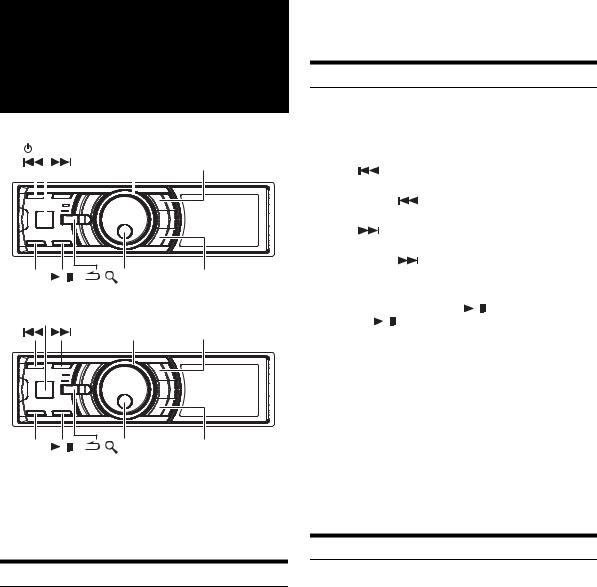
USBmemory/Portableaudio player (iDA-X200 only)/ Changer (Optional)
iDA-X200
SOURCE |
Double Action |
|
|||
|
|
|
encoder |
FUNC./SETUP |
|
|
|
|
|
|
|
|
|
|
|
|
|
|
|
|
|
|
|
BAND / |
/ENTER |
PRESET |
iDA-X300
 SOURCE
SOURCE
Rotary encoder FUNC./SETUP
BAND / |
/ENTER |
PRESET |
If a USB memory device/Portable audio player (iDA-X200 only) or changer is connected to the unit, MP3/WMA/AAC files can be played back.
•In the USB mode, when this unit is reset, ACC is switched from OFF to ON, or when the USB is connected to this unit, “BANKING” is displayed for several seconds.
BANK Function (USB memory)
This unit has a BANK function that automatically divides every 1,000 songs stored in USB memory into individual banks to make searching and playing back a song easier. A maximum of 1,000 songs for one bank can be stored according to the order stored in USB memory. A maximum of 10 banks (10,000 songs) can be recognized. BANK1 (songs 1 to 1,000) is set as the default. If you want to search beyond 1,000 songs, perform the following operation to select a different bank.
BANK No. |
Song number |
BANK1 |
1~1,000 |
|
|
BANK2 |
1,001~2,000 |
|
|
... |
... |
BANK10 |
9,001~10,000 |
|
|
1 Press PRESET.
The BANK selection mode is displayed.
2 Turn the Double Action encoder (iDA-X200 only) or Rotary encoder (iDA-X300 only).
Select the desired BANK.
You can scroll the page by pressing and turning the Double Action encoder. (iDA-X200 only.)
14-EN
3 Press  /ENTER.
/ENTER.
Each operation can be performed in the selected bank.
•Even if the files are contained in the same folder, they may be saved as different BANK.
Playback
1 Press SOURCE to select the USB AUDIO or CD CHANGER mode.
SOURCE to select the USB AUDIO or CD CHANGER mode.
2 Press or
or to select the desired track (file).
to select the desired track (file).
Returning to the beginning of the current track (file):
Press .
Fast backward: |
|
Press and hold |
. |
Advancing to the beginning of the next track (file):
Press .
Fast forward: |
|
Press and hold |
. |
•When a Portable audio player is connected, fast-forwarding/fast- reversing is not available.
3 To pause playback, press / .
Pressing / again will resume playback.
•WMA format files that are protected by DRM (Digital Rights Management), AAC format files that have been purchased from the iTunes Store and files that are copy-protected (copyright protection) cannot be played back on this unit.
•The playback time may not be correctly displayed when a VBR (Variable Bit Rate) recorded file is played back.
•If there is tag information, artist name/album name/track name is displayed.
•ID3 tag/WMA tag
If an MP3/WMA/AAC file contains ID3 tag/WMA tag information, the ID3 tag/WMA tag information is displayed (e.g., song name, artist name, and album name). All other tag data is ignored.
•“NO SUPPORT” is displayed when text information is not compatible with this unit.
•Before disconnecting USB memory, be sure to change to another source or set to pause.
Selecting a Disc (Changer) (Optional)
An optional 6-disc or 12-disc CD Changer may be connected to this unit if it is Ai-NET compatible. With a CD Changer connected to the Ai-NET input of this unit, the CD Changer will be controllable from this unit.
Using the KCA-410C (Versatile Link Terminal) multiple changers can be controlled by this unit.
See “Multi-Changer Selection (Optional)” on page 15 for selecting the CD Changers.
•The controls on this unit for CD Changer operation are operative only when a CD Changer is connected.
•The DVD changer (optional) is controllable from this unit as well as the CD changer.
1 Press PRESET.
The DISC CHANGE screen is displayed.
2 Turn the Double Action encoder (iDA-X200 only) or Rotary encoder (iDA-X300 only) to select a disc.
You can scroll the page by pressing and turning the Double Action encoder. (iDA-X200 only.)
3 Press  /ENTER.
/ENTER.
The selected disc number appears in the display and CD/MP3/WMA/AAC playback starts.
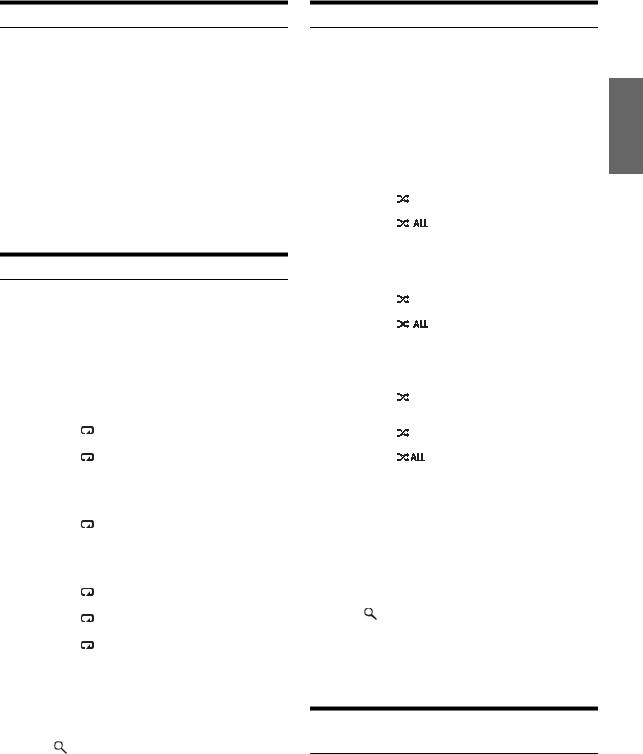
Multi-Changer Selection (Optional)
When using KCA-410C (Versatile Link Terminal), you can connect two changers and two external outputs (AUX).
1 Press  SOURCE on this unit to activate the CD CHANGER mode.
SOURCE on this unit to activate the CD CHANGER mode.
2 Press BAND to activate the CD Changer Selection mode.
The CD Changer Selection mode remains active for several seconds.
3 Press BAND until the desired CD Changer appears on the display.
•For further details about the external input (AUX) when using KCA-410C, see “Setting the AUX+ NAME Mode” on page 24.
Repeat Play
1 Press FUNC./SETUP.
2 Press  /ENTER.
/ENTER.
The repeat mode is activated.
3 Turn the Double Action encoder (iDA-X200 only) or Rotary encoder (iDA-X300 only) to select the Repeat playback mode.
USB memory mode :
REPEAT ONE |
: Only a track is repeatedly played |
|
back. |
FOLDER |
: Only files in a folder are repeatedly |
|
played back. |
OFF |
: Repeat mode is turned off. |
Portable audio player mode (iDA-X200 only) |
|
REPEAT SONG |
: Only a track is repeatedly played |
|
back. |
OFF |
: Repeat mode is turned off. |
CD Changer mode : |
|
REPEAT ONE |
: Only a file is repeatedly played back. |
FOLDER * |
: Only files in a folder are repeatedly |
|
played back. |
DISC |
: A disc is repeatedly played back. |
OFF |
: Repeat mode is turned off. |
* When an MP3 compatible CD changer is connected.
•If REPEAT DISC is set to ON during M I X ONE play in CD changer mode, M.I.X. will apply to the current disc only.
4 |
Press /ENTER. |
5 |
Press FUNC./SETUP. |
|
The track (file) will be played repeatedly. |
•If no operation is performed for 10 seconds, the unit returns to normal mode.
•To cancel, select OFF in the above procedure.
M.I.X. (Random Play)
1 Press FUNC./SETUP.
2 Turn the Double Action encoder (iDA-X200 only) or Rotary encoder (iDA-X300 only) to select M I X.
3 Press  /ENTER.
/ENTER.
The M.I.X. mode is activated.
4 Turn the Double Action encoder (iDA-X200 only) or Rotary encoder (iDA-X300 only) to select the M I X playback mode.
USB memory mode :
M I X FOLDER |
: Only files in a folder are played |
|
back in random sequence. |
ALL |
: All songs in USB memory (current |
|
Bank) are played back in random |
|
sequence. |
OFF |
: M.I.X. mode is turned off. |
Portable audio player mode (iDA-X200 only)
M I X SONG |
: Only files in a folder are played |
|
back in random sequence. |
ALL |
: All songs in Portable audio player |
|
are played back in random |
|
sequence. |
OFF |
: M.I.X. mode is turned off. |
CD Changer mode : |
|
M I X ONE |
: All files in a disc are played back in |
|
random sequence, and playback |
|
shifts to the next disc. |
FOLDER *1 |
: Only files in a folder are played |
|
back in random sequence. |
ALL *2 |
: All the tracks on all the CDs in the |
|
current magazine will be played |
|
back in the random sequence. |
OFF |
: M.I.X. mode is turned off. |
*1 When an MP3 compatible CD changer is connected.
*2 When a CD changer equipped with the ALL M.I.X. function is connected.
•When a song is played back during Random (M.I.X.) play in the USB mode, the song can be played back again randomly even if not all songs on the USB Memory have been played back.
•If M I X ONE is set to ON during REPEAT DISC play in CD changer mode, M.I.X. will apply to the current disc only.
5 |
Press /ENTER. |
6 |
Press FUNC./SETUP. |
The tracks (files) will be played back in random sequence.
•If no operation is performed for 10 seconds, the unit returns to normal mode.
•To cancel, select OFF in the above procedure.
Searching for CD Track Number (CD changer only)
You can search for a song by track number.
1 Press  /ENTER during play.
/ENTER during play.
This will set the search mode.
15-EN

2 Turn the Double Action encoder (iDA-X200 only) or Rotary encoder (iDA-X300 only) to select the desired track, and then press  /ENTER.
/ENTER.
This will play the selected track.
•Press  in the search mode to cancel. Or, the search mode is canceled if no operation is performed for 60 seconds.
in the search mode to cancel. Or, the search mode is canceled if no operation is performed for 60 seconds.
•During list selection, if you turn the Double Action encoder to the left or right while pressed, the list screen scrolls screen by screen. If you turn and hold the Double Action encoder to the left or right while pressed, the list screen continuously scrolls (iDA-X200 only).
•When CD Track Number Search is made during M.I.X. play, the M.I.X. play mode will be canceled.
Searching for a desired Song (USB memory/Portable audio player (iDA-X200 only))
A USB memory device/Portable audio player can contain hundreds of songs. By using file tag information and keeping these songs organized in playlists, this unit’s search functions will ease song searches.
Each music category has its own individual hierarchy. Use the Playlist/ Artist/Album/Genre/Composer/Song/Folder/File search mode to narrow searches based on the table below.
Hierarchy 1 |
Hierarchy 2 |
Hierarchy 3 |
Hierarchy 4 |
|
|
|
|
PLAYLIST |
SONG |
— |
— |
|
|
|
|
ARTIST |
ALBUM |
SONG |
— |
|
|
|
|
ALBUM |
SONG |
— |
— |
|
|
|
|
GENRE |
ARTIST |
ALBUM |
SONG |
|
|
|
|
COMPOSER |
ALBUM |
SONG |
— |
|
|
|
|
SONG |
— |
— |
— |
|
|
|
|
FOLDER |
FILE |
— |
— |
|
|
|
|
FILE |
— |
— |
— |
|
|
|
|
For example: Searching by Artist name
The following example explains how an ARTIST search is performed. Another search mode can be used for the same operation, although the hierarchy differs.
1 Press  /ENTER to activate the search selection mode.
/ENTER to activate the search selection mode.
2 Turn the Double Action encoder (iDA-X200 only) or Rotary encoder (iDA-X300 only) to select the ARTIST search mode, and then press  /ENTER.
/ENTER.
PLAYLIST  ARTIST
ARTIST  ALBUM
ALBUM  GENRE
GENRE  COMPOSER
COMPOSER  SONG
SONG  FOLDER
FOLDER  FILE
FILE  PLAYLIST
PLAYLIST
3 Turn the Double Action encoder (iDA-X200 only) or Rotary encoder (iDA-X300 only) to select the desired Artist, and then press  /ENTER.
/ENTER.
4 Turn the Double Action encoder (iDA-X200 only) or Rotary encoder (iDA-X300 only) to select an album, and then press  /ENTER.
/ENTER.
5 Turn the Double Action encoder (iDA-X200 only) or Rotary encoder (iDA-X300 only) to select a song and press  /ENTER.
/ENTER.
The selected song is played back.
•After pressing and holding  /ENTER for at least 2 seconds while in each hierarchy (except SONG/FILE hierarchy),all songs of the selected hierarchy are played back.
/ENTER for at least 2 seconds while in each hierarchy (except SONG/FILE hierarchy),all songs of the selected hierarchy are played back.
•Press and hold  for at least 2 seconds in the search mode to cancel.
for at least 2 seconds in the search mode to cancel.
16-EN
•While in the Search mode, press  to switch to the previous mode.
to switch to the previous mode.
•When search is made during M.I.X. play, the M.I.X play mode will be canceled.
•“ROOT” is displayed for the root folder which does not have folder name.
•In the search mode, you can scroll the page by pressing and turning the Double Action encoder (iDA-X200 only).
•If no operation is performed for 60 seconds, the unit will return to normal mode automatically.
•In the search mode, when there is no tag information in the searched files, “NO DATA” will be displayed, it may also be displayed when searching some files depending on the property of the files.
•In FOLDER/FILE search mode, only the current BANK’s folders/ files can be searched.
File/Folder Name Search (MP3 Changer)
Folder and file names may be searched and displayed during playback.
1 During MP3/WMA/AAC playback, press  /ENTER to activate the search mode.
/ENTER to activate the search mode.
2 Turn the Double Action encoder (iDA-X200 only) or Rotary encoder (iDA-X300 only) to select Folder Name Search mode or File Name Search mode, and then press  /ENTER.
/ENTER.
Folder Name Search mode
3 Turn the Double Action encoder (iDA-X200 only) or Rotary encoder (iDA-X300 only) to select the desired folder.
You can scroll the page by pressing and turning the Double Action encoder (iDA-X200 only).
4 Press and hold  /ENTER for at least 2 seconds to play back the first file in the selected folder.
/ENTER for at least 2 seconds to play back the first file in the selected folder.
•Press and hold  for at least 2 seconds in the search mode to cancel. Or, the search mode is cancelled if no operation is performed for 60 seconds.
for at least 2 seconds in the search mode to cancel. Or, the search mode is cancelled if no operation is performed for 60 seconds.
•To search for files in the Folder Name Search mode, press
 /ENTER. Files in the folder may be searched.
/ENTER. Files in the folder may be searched.
•Press  to exit Folder Name Search mode in step 3 in order to select File Name Search mode.
to exit Folder Name Search mode in step 3 in order to select File Name Search mode.
•“ROOT” is displayed for the root folder which does not have folder name.
•When Folder Name Search is made during M.I.X. play, the M.I.X. play mode will be canceled.
File Name Search mode
3 Select the desired file by turning the Double Action encoder (iDA-X200 only) or Rotary encoder
(iDA-X300 only).
You can scroll the page by pressing and turning the Double Action encoder (iDA-X200 only).
4 Press  /ENTER to play back the selected file.
/ENTER to play back the selected file.
•Press and hold  for at least 2 seconds in the search mode to cancel. Or, the search mode is canceled if no operation is performed for 60 seconds.
for at least 2 seconds in the search mode to cancel. Or, the search mode is canceled if no operation is performed for 60 seconds.
•Press  in the search mode to return to the previous mode.
in the search mode to return to the previous mode.
•When File Name Search is made during M.I.X. play, the M.I.X. play mode will be cancelled.
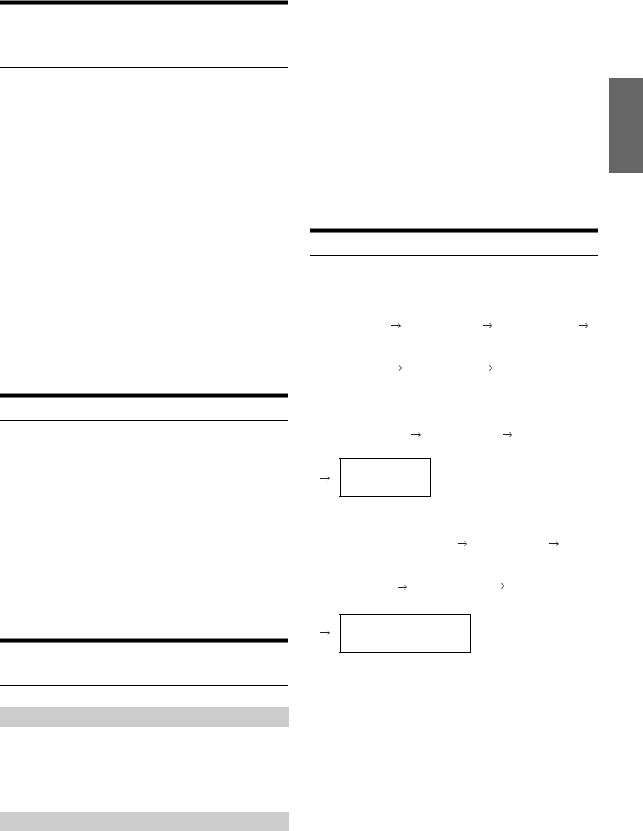
Switching between Quick Search mode and Folder up/down mode (MP3 changer) (iDA-X300 only)
When an MP3 changer is connected, you can switch between the Quick Search mode and Folder up/down mode.
1 Press FUNC./SETUP.
2 Turn the Rotary encoder to select the desired adjust menu.
QUICK SEARCH: Quick Search mode
FOLDER UP/DN: Folder up/down mode (Initial Setting)
3 Press  /ENTER.
/ENTER.
The ON/OFF screen is displayed.
4 Turn the Rotary encoder.
Select ON.
When ON is set, either Quick Search mode or Folder up/ down mode can be used.
5 Press  /ENTER.
/ENTER.
•You cannot set both Quick Search mode and Folder up/down mode to ON.
•If no operation is performed for 10 seconds, the unit will return to normal mode automatically.
Quick Search (changer)
You can search for tracks (files).
1 Press and hold  /ENTER for at least 2 seconds in the Changer mode to activate Quick Search mode.
/ENTER for at least 2 seconds in the Changer mode to activate Quick Search mode.
2 Turn the Double Action encoder (iDA-X200 only) or Rotary encoder (iDA-X300 only) to select a desired track (file).
The selected track is played back immediately.
•Press  in the search mode to cancel. Or, the search mode is canceled if no operation is performed for 10 seconds.
in the search mode to cancel. Or, the search mode is canceled if no operation is performed for 10 seconds.
•When an MP3 changer is connected, set the Quick Search mode to ON. For details, refer to “Switching between Quick Search mode and Folder up/down mode (MP3 changer) (iDA-X300 only)” (iDA-X300 only) (page 17).
Select the desired Folder (Folder up/ down) (MP3/WMA/AAC)
By using this function on iDA-X200
Press and turn the Double Action encoder to select the desired folder.
Turning to the right will advance to the next folder. Turning to the left will return to the previous folder. The first file in the selected folder is played back.
By using this function on iDA-X300
1 Press  /ENTER for at least 2 seconds.
/ENTER for at least 2 seconds.
The Folder up/down mode is activated.
2 Turn the Rotary encoder.
Turning to the right will advance to the next folder. Turning to the left will return to the previous folder. The first file in the selected folder is played back.
•When an MP3 changer is connected, set the Folder up/down mode to ON. For details, refer to “Switching between Quick Search mode and Folder up/down mode (MP3 changer) (iDA-X300 only)” (iDA-X300 only) (page 17).
•If no operation is performed for 10 seconds, the unit will return to normal mode automatically (iDA-X300 only).
•USB Memory/Portable Audio Player (iDA-X200 only)
During playback in normal mode, if you press and turn the Double Action encoder before you perform a search operation, the FOLDER UP/DOWN function will become activate.
During playback in normal mode, if you press and turn the Double Action encoder after you perform a search operation, the Up/Down Function will become activate.
Changing the Display
Press VIEW.
USB/Portable audio player (iDA-X200 only) mode:
Track No. |
|
Folder Name |
|
Song Name*1 |
|
Elapsed Time |
|
File Name |
|
Artist Name*1 |
|
|
|
|
|
|
|
Song Name*1 |
|
Calendar |
|
Track No. |
|
Album Name*1 |
|
Clock |
|
Elapsed Time |
|
CD Changer mode: |
|
|
|
||
|
|
|
|
|
|
|
Disc No. / Track No. |
|
Track Text*2 |
|
Calendar |
|
Elapsed Time |
|
Disc Text*3 |
|
Clock |
Disc No. / Track No.
Elapsed Time
MP3 Changer mode: |
|
|
|
|
|
|
|
|
||
|
|
|
|
|
|
|
|
|
|
|
|
Disc No. / Folder No. / File No. |
|
|
Folder Name |
|
|||||
|
Elapsed Time |
|
|
|
File Name |
|
|
|||
|
|
|
|
|
|
|
|
|
|
|
|
|
|
|
|
|
|
|
|||
|
Song Name*1 |
|
Song Name*1 |
|
|
|
Calendar |
|||
|
Artist Name*1 |
|
Album Name*1 |
|
|
Clock |
||||
Disc No. / Folder No. / File No.
Elapsed Time
*1 TAG information
“ARTIST”/“ALBUM”/“SONG” is displayed if there is no tag information.
*2 “T TEXT” is displayed if there is no Track Text. *3 “D TEXT” is displayed if there is no Disc Text.
•Only alphanumeric characters can be displayed.
•The maximum number of characters is 128 (128 byte) for USB and Portable audio player.
•The maximum number of characters is 64 (64byte) for Changer.
•Some characters may not be correctly displayed.
•“NO SUPPORT” is displayed when text information is not compatible with this unit.
17-EN
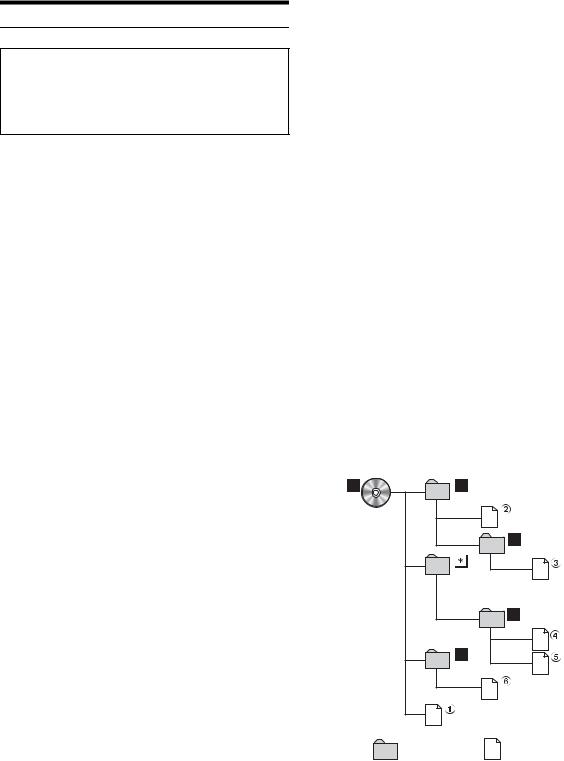
About MP3/WMA/AAC
CAUTION
Except for private use, duplicating audio data (including MP3/ WMA/AAC data) or distributing, transferring, or copying it, whether for free or for a fee, without permission of the copyright holder is strictly prohibited by the Copyright Act and by international treaty.
What is MP3?
MP3, whose official name is “MPEG-1 Audio Layer 3,” is a compression standard prescribed by the ISO, the International Standardization Organization and MPEG which is a joint activity institution of the IEC.
MP3 files contain compressed audio data. MP3 encoding is capable of compressing audio data at extremely high ratios, reducing the size of music files to as much as one-tenth their original size. This is achieved while still maintaining near CD quality. The MP3 format realizes such high compression ratios by eliminating the sounds that are either inaudible to the human ear or masked by other sounds.
What is AAC?
AAC is the abbreviation for “Advanced Audio Coding,” and is a basic format of audio compression used by MPEG2 or MPEG4.
What is WMA?
WMA, or “Windows media™ Audio,” is compressed audio data. WMA is similar to MP3 audio data and can achieve CD quality sound with small file sizes.
Method for creating MP3/WMA/AAC files
Audio data is compressed by using MP3/WMA/AAC specified software. For details on creating MP3/WMA/AAC files, refer to the user’s manual for that software.
MP3/WMA/AAC file extensions that can be played back on the unit are as follows:
MP3: “mp3”
WMA: “wma” (ver. 7.1, 8, 9, 9.1, 9.2 supported) AAC: “m4a”
WMA is not supported for the following files, Windows Media Audio Professional, Windows Media Audio 9 Voice or Windows Media Audio 9 Pro Lossless.
Depending on the software that is used to create AAC, the file format may differ from the extension.
Playback of AAC files encoded by iTunes is supported.
Supported playback sampling rates and bit rates
MP3 |
|
|
Sampling rates: 48 kHz, |
44.1 kHz, 32 kHz, 24 kHz, 22.05 kHz, |
|
|
16 kHz, |
12 kHz, 11.025 kHz, 8 kHz |
Bit rates: |
32 - 320 kbps |
|
WMA |
|
|
Sampling rates: 48 kHz, |
44.1 kHz, 32 kHz, 24 kHz, 22.05 kHz, |
|
|
16 kHz |
|
Bit rates: |
16 - 320 kbps |
|
AAC |
|
|
Sampling rates: 48 kHz, |
44.1 kHz |
|
Bit rates: |
8 - 576 kbps |
|
This device may not play back correctly depending on sampling rates.
The playback time may not be correctly displayed when a VBR (Variable Bit Rate) recorded file is played back.
ID3 tags/WMA tags
This device supports ID3 tag v1 and v2.2.0, v2.3.0 and WMA tag. The following files do not support compression, coding, grouping or non-synchronization.
If tag data is in an MP3/WMA/AAC file, this device can display the title (track title), artist name, and album name ID3 tag/WMA tag data.
This device can only display single-byte alphanumeric characters and the underscore. For non-supported characters, “NO SUPPORT” is displayed.
The tag information may not be correctly displayed, depending on the contents.
Do not make a file’s playback time more than 1 hour.
Playing back MP3/WMA/AAC
MP3/WMA/AAC files are prepared, and then written to USB memory. Or, synchronize an MP3/WMA file using Windows Media Player (Ver. 7.1, 8, 9, 9.1, 9.2), and then forward to the Portable audio player.
A USB memory device can hold up to 10,000 files/1000 folders (including Root Folders). Playback may not be performed if a USB memory / Portable audio player device exceeds the limitations described above.
Do not make a file’s playback time more than 1 hour.
Media supported
This device can play back USB memory / Portable audio player media.
Corresponding File Systems
This device supports FAT 12/16/32.
Order of tracks
The unit plays the files in the order that the writing software writes them. Therefore, the playing order may not be the same as the order you input. The playback order of the folders and files is as follows. However, the folder and file playback order differs from the folder and file number indicated on the display.
Root folder |
|
Folder |
MP3/WMA/AAC File |
*The folder No./folder Name will not be displayed if no file is contained in the folder.
18-EN
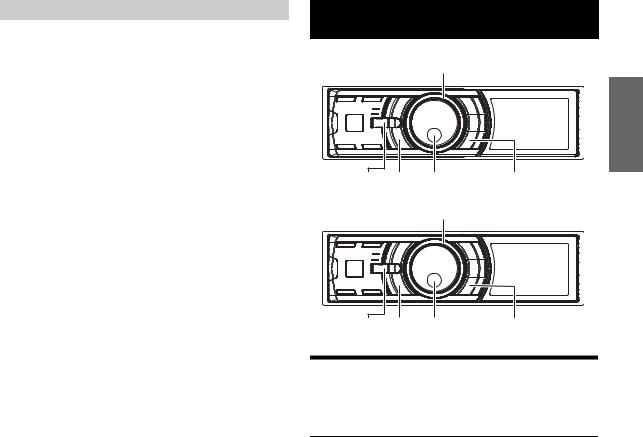
Terminology
Bit rate
This is the “sound” compression rate specified for encoding. The higher the bit rate, the higher the sound quality, but also the larger the files.
Sampling rate
This value shows how many times per second the data is sampled (recorded). For example, music CDs use a sampling rate of 44.1 kHz, so the sound is sampled (recorded) 44,100 times per second. The higher the sampling rate, the higher the sound quality, but also the larger the volume of data.
Encoding
Converting music CDs, WAVE (AIFF) files, and other sound files into the specified audio compression format.
Tag
Song information such as track titles, artist names, album names, etc., written into MP3/WMA/AAC files.
Root folder
The root folder is found at the top of the file system. The root folder contains all folders and files.
Sound Setting
iDA-X200
Double Action encoder
 IMPRINT
IMPRINT  /ENTER PRESET
/ENTER PRESET
iDA-X300
Rotary encoder
 SOUND
SOUND  /ENTER PRESET
/ENTER PRESET
Adjusting Subwoofer/Bass/Treble/
Balance (Between Left and Right)/Fader
(Between Front and Rear)/Loudness/
Defeat
1 Press IMPRINT (iDA-X200 only) or SOUND (iDAX300 only) repeatedly to choose the desired mode.
Each press changes the mode as follows:
SUBW LV*1  BASS LV
BASS LV  TREBLE LV
TREBLE LV  BALANCE LV
BALANCE LV  FADER LV*2
FADER LV*2  LOUD*3
LOUD*3  DEFEAT
DEFEAT  VOLUME
VOLUME 
SUBW LV*1
Subwoofer: 0 ~ 15
Bass level: –7 ~ +7
Treble level: –7 ~ +7
Balance: –15 ~ +15
Fader: –15 ~ +15
Loudness : ON/OFF
Defeat : ON/OFF
Volume: 0 ~ 35
•If IMPRINT (iDA-X200 only) or SOUND (iDA-X300 only) is not pressed within 5 seconds after selecting the Subwoofer, Bass, Treble, Balance or Fader mode, the unit automatically returns to normal mode.
•Loudness introduces a special low-and high-frequency emphasis at low listening levels. This compensates for the ear’s decreased sensitivity to bass and treble sound. The function is inoperable when DEFEAT is set to ON.
*1 When the subwoofer mode is set to OFF, its level cannot be adjusted. *2 If you set the 4.2ch (FRONT/REAR/SUBW.)/2.2ch (3WAY) switch of the IMPRINT audio processor (PXA-H100) to 2.2ch (3WAY), you cannot adjust the FADER mode. For details, refer to the Owner’s
Manual of PXA-H100.
*3 When an external audio processor is connected, this setting cannot be made.
2 Turn the Double Action encoder (iDA-X200 only) or Rotary encoder (iDA-X300 only) until the desired sound is obtained in each mode.
•Depending on the connected devices, some functions and display indications do not work.
19-EN
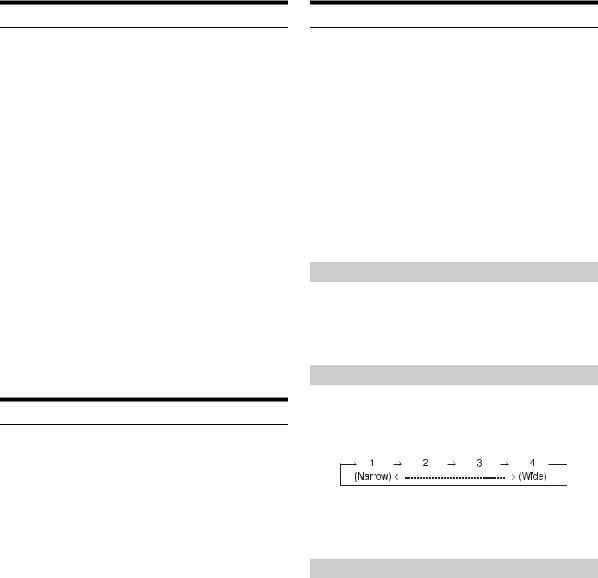
Turning Subwoofer ON/OFF
When the subwoofer is on, you can adjust the subwoofer output level (refer to page 19).
For iDA-X200, the following setting can be made only when the IMPRINT audio processor (PXA-H100) is not connected.
1 Press and hold IMPRINT (iDA-X200 only) or SOUND (iDA-X300 only) for at least 2 seconds to activate the AUDIO selection mode.
2 Turn the Double Action encoder (iDA-X200 only) or Rotary encoder (iDA-X300 only) to select the SUBW mode, and then press  /ENTER.
/ENTER.
SUBW  SUBW SYSTEM*
SUBW SYSTEM*  BASS
BASS  TREBLE
TREBLE  HPF
HPF  SUBW
SUBW
* Displayed only when subwoofer is ON.
3 Turn the Double Action encoder (iDA-X200 only) or Rotary encoder (iDA-X300 only) to select SUBW ON/OFF, and then press  /ENTER.
/ENTER.
ON  OFF
OFF
4 Press  to return to normal mode.
to return to normal mode.
•If no operation is performed for 15 seconds, the unit will return to normal mode automatically.
•If  is pressed during setting, the unit returns to the previous item.
is pressed during setting, the unit returns to the previous item.
Setting the Subwoofer System
When the subwoofer is on, you can select either SYS 1 or SYS 2 for the desired subwoofer effect.
For iDA-X200, the following setting can be made only when the IMPRINT audio processor (PXA-H100) is not connected.
1 Press and hold IMPRINT (iDA-X200 only) or SOUND (iDA-X300 only) for at least 2 seconds to activate the AUDIO selection mode.
2 Turn the Double Action encoder (iDA-X200 only) or Rotary encoder (iDA-X300 only) to select the SUBW SYSTEM mode, and then press  /ENTER.
/ENTER.
SUBW  SUBW SYSTEM*
SUBW SYSTEM*  BASS
BASS  TREBLE
TREBLE  HPF
HPF  SUBW
SUBW
* Displayed only when subwoofer is ON.
3 Turn the Double Action encoder (iDA-X200 only) or Rotary encoder (iDA-X300 only) to select the SUBW SYS 1 or SUBW SYS 2, and then press
 /ENTER.
/ENTER.
SYS 1  SYS 2
SYS 2
4 Press  to return to normal mode.
to return to normal mode.
•If no operation is performed for 15 seconds, the unit will return to normal mode automatically.
•If  is pressed during setting, the unit returns to the previous item.
is pressed during setting, the unit returns to the previous item.
•This function is inoperable when Subwoofer is set to OFF.
Setting the Bass Control
You can change the Bass Frequency emphasis to create your own tonal preference.
For iDA-X200, the following setting can be made only when the IMPRINT audio processor (PXA-H100) is not connected.
1 Press and hold IMPRINT (iDA-X200 only) or SOUND (iDA-X300 only) for at least 2 seconds to activate the AUDIO selection mode.
2 Turn the Double Action encoder (iDA-X200 only) or Rotary encoder (iDA-X300 only) to select the BASS Adjustment mode, and then press
 /ENTER.
/ENTER.
SUBW  SUB SYSTEM*
SUB SYSTEM*  BASS
BASS  TREBLE
TREBLE  HPF
HPF  SUBW
SUBW
* Displayed only when subwoofer is ON.
Setting the Bass Level
3-1*1Turn the Double Action encoder (iDA-X200 only) or Rotary encoder (iDA-X300 only) to select the desired bass level (–7~+7), and then press
 /ENTER.
/ENTER.
You can emphasize or weaken the bass level.
Setting the Bass Bandwidth
3-2 Turn the Double Action encoder (iDA-X200 only) or Rotary encoder (iDA-X300 only) to select the desired bass bandwidth, and then press  /ENTER.
/ENTER.
Changes the boosted bass bandwidth to wide or narrow. A wider setting will boost a wide range of frequencies above and below the center frequency. A narrower setting will boost only frequencies near the center frequency.
Setting the Bass Center Frequency
3-3 Turn the Double Action encoder (iDA-X200 only) or Rotary encoder (iDA-X300 only) to select the desired bass center frequency, and then press
 /ENTER.
/ENTER.
80(Hz)  100(Hz)
100(Hz)  200(Hz)
200(Hz)  60(Hz)
60(Hz)  80(Hz)
80(Hz)
Emphasizes the displayed bass frequency ranges.
4 Press  to return to normal mode.
to return to normal mode.
•If no operation is performed for 15 seconds, the unit will return to normal mode automatically.
•If  is pressed during setting, the unit returns to the previous item.
is pressed during setting, the unit returns to the previous item.
•The function is inoperable when DEFEAT is set to ON.
*1 The adjustment can also be made by pressing IMPRINT (iDA-X200 only) or SOUND (iDA-X300 only). Refer to “Adjusting Subwoofer/ Bass/Treble/Balance(Between Left and Right)/Fader (Between Front and Rear)/Loudness/Defeat” (page 19).
20-EN

Setting the Treble Control
You can change the Treble Frequency emphasis to create your own tonal preference.
For iDA-X200, the following setting can be made only when the IMPRINT audio processor (PXA-H100) is not connected.
1 Press and hold IMPRINT (iDA-X200 only) or SOUND (iDA-X300 only) for at least 2 seconds to activate the Audio Selection mode.
2 Turn the Double Action encoder (iDA-X200 only) or Rotary encoder (iDA-X300 only) to select the TREBLE Adjustment mode, and then press
 /ENTER.
/ENTER.
SUBW  SUBW SYSTEM*
SUBW SYSTEM*  BASS
BASS  TREBLE
TREBLE  HPF
HPF  SUBW
SUBW
* Displayed only when subwoofer is ON.
Setting the Treble Level
3-1*2Turn the Double Action encoder (iDA-X200 only) or Rotary encoder (iDA-X300 only) to select the desired treble level (–7~+7), and then press
 /ENTER.
/ENTER.
You can emphasize the treble level.
Setting the Treble Center Frequency
3-2 Turn the Double Action encoder (iDA-X200 only) or Rotary encoder (iDA-X300 only) to select the desired treble center frequency, and then press
 /ENTER.
/ENTER.
10.0 kHz  12.5 kHz
12.5 kHz  15.0 kHz
15.0 kHz  17.5 kHz
17.5 kHz  10.0 kHz
10.0 kHz
Emphasizes the displayed treble frequency ranges.
4 Press  to return to normal mode.
to return to normal mode.
•If no operation is performed for 15 seconds, the unit will return to normal mode automatically.
•If  is pressed during setting, the unit returns to the previous item.
is pressed during setting, the unit returns to the previous item.
•The function is inoperable when DEFEAT is set to ON.
*2 The adjustment can also be made by pressing IMPRINT (iDA-X200 only) or SOUND (iDA-X300 only). Refer to “Adjusting Subwoofer/ Bass/Treble/Balance(Between Left and Right)/Fader (Between Front and Rear)/Loudness/Defeat” (page 19).
Adjusting the High Pass Filter
The High Pass Filter on this unit can be adjusted to suit your personal taste.
For iDA-X200, the following setting can be made only when the IMPRINT audio processor (PXA-H100) is not connected.
1 Press and hold IMPRINT (iDA-X200 only) or SOUND (iDA-X300 only) for at least 2 seconds to activate the AUDIO selection mode.
2 Turn the Double Action encoder (iDA-X200 only) or Rotary encoder (iDA-X300 only) to select the HPF Adjustment mode, and then press  /ENTER.
/ENTER.
SUBW  SUB SYSTEM*
SUB SYSTEM*  BASS
BASS  TREBLE
TREBLE  HPF
HPF  SUBW
SUBW
* Displayed only when subwoofer is ON.
3 Turn the Double Action encoder (iDA-X200 only) or Rotary encoder (iDA-X300 only) to select the desired HPF frequency, and then press  /ENTER.
/ENTER.
OFF  80 (Hz)
80 (Hz)  120 (Hz)
120 (Hz)  160 (Hz)
160 (Hz)
4 Press  to return to normal mode.
to return to normal mode.
•If no operation is performed for 15 seconds, the unit will return to normal mode automatically.
•If  is pressed during setting, the unit returns to the previous item.
is pressed during setting, the unit returns to the previous item.
•The function is inoperable when DEFEAT is set to ON.
Operating the External Audio Processor
You can call up the preset memory of the external audio processor from this unit.
1 Press and hold PRESET for at least 2 seconds to call the external audio processor mode when the external audio processor is connected.
The AP Preset screen is displayed.
2 Turn the Double Action encoder (iDA-X200 only) or Rotary encoder (iDA-X300 only) to select the preset number, and press  /ENTER.
/ENTER.
•For the operation of external audio processor, refer to the Owner’s Manual of the external audio processor you purchased.
21-EN
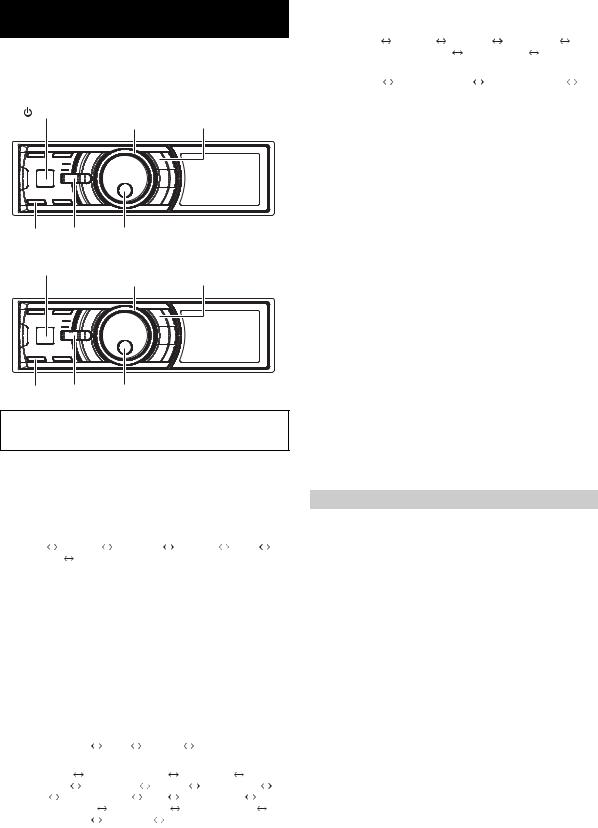
SETUP
Use the SETUP menu to flexibly customize the unit to suit your own preferences and usage. Choose settings from GENERAL,DISPLAY, etc., to make the desired changes.
iDA-X200
SOURCE
Double Action encoder FUNC./SETUP
BAND 
 /ENTER iDA-X300
/ENTER iDA-X300
 SOURCE
SOURCE
Rotary encoder FUNC./SETUP
BAND 
 /ENTER
/ENTER
Follow steps 1 to 5 to choose an item to change. See the item descriptions following Step 5 for further details.
1 Press and hold FUNC./SETUP for at least 2 seconds to activate the SETUP selection mode.
2 Turn the Double Action encoder (iDA-X200 only) or Rotary encoder (iDA-X300 only) to select the desired item, and then press  /ENTER.
/ENTER.
BT*1 |
AUDIO*2 |
GENERAL DISPLAY IPOD |
TUNER*3 |
BT |
|
(e.g. Select GENERAL)
*1 Displayed only when INT MUTE is set to OFF, and the mode is set to other than BT AUDIO.
*2 Displayed only when an external audio processor is connected. For details, refer to the Owner’s Manual of the external audio processor.
*3 Only when HD / SAT receiver is connected.
3 Turn the Double Action encoder (iDA-X200 only) or Rotary encoder (iDA-X300 only) to select a setting item, and then press  /ENTER.
/ENTER.
(e.g. Select POWER IC)
BT: |
|
|
|
|
BT IN |
|
|
|
|
AUDIO*4: |
|
|
|
|
USER PRESET*5 |
MX*5 |
SUBW*5 |
MX LEVEL*6 |
|
GENERAL: |
CALENDAR ADJ*7 |
|
||
CALENDAR |
CLK MODE |
|||
CLK ADJ*8 |
PLAY MODE |
BEEP*9 INT MUTE*10 |
||
AUX+ AUX+ NAME*11 |
AUX |
AUX NAME*11 |
||
CHANGER NAME |
DIGITAL AUX |
D-AUX NAME*12 |
||
AUX IN GAIN*13 |
POWER IC DEMO |
|||
22-EN
DISPLAY:
DIMMER SCROLL TYPE
SCROLL TYPE TEXT SCROLL
TEXT SCROLL
IPOD:
PLAYLISTS ARTISTS ALBUMS PODCASTS AUDIOBOOKS GENRES COMPOSERS SONGS
GENRES COMPOSERS SONGS
TUNER: |
|
|
|
|
XM_ADF*14 |
GAME_ALERT*14 |
STATION CALL*15 |
|
DIGITAL SEEK*15 |
|
|
*4 |
If IMPRINT audio processor is connected, you can make more |
||
|
detailed settings for the audio setting. For details, refer to |
||
*5 |
“IMPRINT Operation (Optional) (iDA-X200 only)” (page 30). |
||
Displayed only when an external audio processor is connected. |
|||
*6 |
Displayed only when MX is set to ON and an external audio |
||
|
processor is connected (or the IMPRINT audio processor is |
||
*7 |
connected (iDA-X200 only)). |
|
|
Refer to “Setting the Calendar” (page 8). |
|||
*8 |
Refer to “Setting the Time” (page 8) . |
|
|
*9 |
iDA-X200 only. |
|
|
*10 |
Displayed only when BT IN is OFF. |
|
|
*11 |
The setting can be made only when AUX+/AUX is set to ON. |
||
*12 |
Displayed only when DIGITAL AUX is set to ON. |
||
*13 |
Displayed only when AUX+ is set to ON. |
||
*14 |
Displayed only when SAT radio receiver is connected. |
||
|
For the SAT Radio Setting, refer to “SAT Radio Receiver |
||
*15 |
(Optional)” (page 25). |
|
|
Displayed only when HD Radio TUNER MODULE (TUA-T500 HD) |
|||
is connected.
4 Turn the Double Action encoder (iDA-X200 only) or Rotary encoder (iDA-X300 only) to change the setting, and then press  /ENTER.
/ENTER.
(e.g. Select POWER IC ON or POWER IC OFF.)
5 Press and hold  for 2 seconds to return to normal mode.
for 2 seconds to return to normal mode.
• Pressing  during the procedure will return to the previous mode.
during the procedure will return to the previous mode.
•If no operation is performed for 60 seconds, the unit will return to normal mode automatically.
Bluetooth Setting
Select BT from the setup main menu in step 2 above.
If an optional Bluetooth Box is connected, you can place a hands-free call by a Bluetoothequipped mobile phone.
Make this setting when the Bluetooth Box is connected and the Bluetooth function is used. For details, refer to the Owner’s Manual of the optional Bluetooth Box.
Set ADPT when the Bluetooth Box is connected.
•If the Bluetooth Box compatible with the Voice Dial function is connected, the Voice Dial function can be used.
•When INT MUTE is set to ON, the Bluetooth setting cannot be made. When the Bluetooth box is connected, set INT MUTE to OFF. Refer to “Turning Mute Mode On/Off (INT MUTE)” (page 23).
Setting the Bluetooth Connection
BT IN ADPT / BT IN OFF (Initial Setting)

Audio Setting (Only when external audio processor is connected)
AUDIO is selected on the setup menu in step 2.
Operating the External Audio Processor (USER PRESET)
PRE-1 (Initial Setting) / PRE-2 / PRE-3 / PRE-4 / PRE-5 / PRE-6
Turn the Double Action encoder(iDA-X200 only) or Rotary encoder(iDA-X300 only) to select the desired preset number, and then press  /ENTER.
/ENTER.
In normal mode, you can also call up the preset memory of the external audio processor by pressing and holding “PRESET” for at least 2 seconds. Refer to “Operating the External Audio Processor” on page 21.
•For the operation of external audio processor, refer to the Owner’s Manual of the external audio processor you purchased.
Turning Media Xpander ON/OFF
OFF (Initial setting) / ON
When the Media Xpander is on, and external audio processor is connected, you can adjust the Media Xpander level.
Setting the MX Level
NON EFFECT / LEVEL 1 / LEVEL 2 / LEVEL 3
MX (Media Xpander) makes vocals or instruments sound distinct regardless of the music source. The FM radio, CD, USB memory and iPod, will be able to reproduce the music clearly even in cars with a lot of road noise. The initial setting is different depending on the source.
Subwoofer On and Off
SUBW ON (Initial setting) / SUBW OFF
The adjustment can also be made by pressing and holding IMPRINT* (iDA-X200 only) or SOUND (iDA-X300 only) for at least 2 seconds. Refer to “Turning Subwoofer ON/OFF” (page 20).
*For iDA-X200, when connecting IMPRINT audio processor, you can’t turn the subwoofer ON or OFF by pressing IMPRINT.
General Setting
GENERAL is selected on the setup main menu in step 2.
Setting of Calendar Display Pattern Switching (CALENDAR)
M/D/Y (Initial setting) / Y/M/D / D/M/Y
You can switch the calendar display pattern to be shown when the time is displayed.
Y : shows the year
M : shows the month
D : shows the day
ex. M/D/Y  12/31/2007
12/31/2007
Setting the Clock Display (CLK MODE)
24H / 12H (Initial setting)
You can select the clock display type, 12-hour or 24-hour, depending on your preference.
Connecting an MP3 Changer (PLAY MODE)
CD-DA (Initial setting) / CD-DA&MP3
Perform this setting when connecting MP3 changer. MP3 changer can playback CDs containing both CD and MP3 data. However, in some situations (some enhanced CDs), playback may be difficult. For these special cases, you can select playback of CD data only. When a disc contains both CD or the MP3 data, playback starts from the CD data portion of the disc.
CD-DA : Only CD data can be played back. CD-DA&MP3 : Both CD data and MP3 file tracks can be played
back.
• Change discs after performing this setting.
Sound (Beep) Guide Function (iDA-X200 only)
Beep On (Initial setting) / Beep Off
This function will give audible feedback with varying tones depending upon the button pressed.
Turning Mute Mode On/Off (INT MUTE)
INT MUTE ON / INT MUTE OFF (Initial setting)
If a device having the interrupt feature is connected, audio will be automatically muted whenever the interrupt signal is received from the device.
•When Bluetooth is set to ADPT, INT MUTE cannot be set. Refer to “Setting the Bluetooth Connection” (page 22).
•When the Bluetooth box is connected, set INT MUTE to OFF.
Setting the AUX+ Mode
AUX+ ON / AUX+ OFF (Initial setting)
You can input the audio of a connected external device, (such as a portable player) to the iPod Direct connector of this unit, using an iPod Direct/RCA Interface cable.
An external device and an iPod cannot be connected at the same time.
AUX+ ON : Set to ON when an external device is connected. If
 SOURCE is pressed and AUX+ is selected, the sound of the external device is input to the unit.
SOURCE is pressed and AUX+ is selected, the sound of the external device is input to the unit.
AUX+ OFF : Set to OFF when an iPod is connected.
23-EN
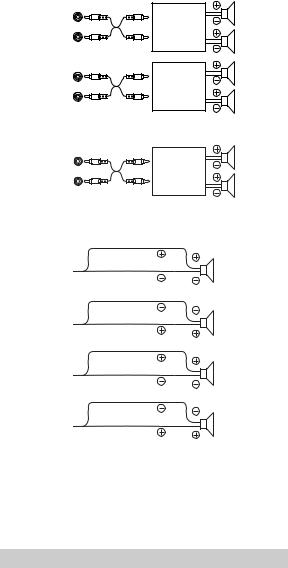
Setting the AUX+ NAME Mode
AUX (Initial setting) / TV / DVD / PORTABLE / GAME
You can change the AUX+ NAME when AUX+ is ON.
Setting the AUX Mode (V-Link)
AUX ON / AUX OFF (Initial setting)
You can input TV/video sound by connecting an optional Ai-NET/RCA Interface cable (KCA-121B) or Versatile Link Terminal (KCA-410C) to this component.
You can change the AUX NAME display when AUX is set to ON. Press
 /ENTER when AUX is set to ON, and select AUX NAME by turning the Double Action encoder (iDA-X200 only) or Rotary encoder (iDA-X300 only) , then press
/ENTER when AUX is set to ON, and select AUX NAME by turning the Double Action encoder (iDA-X200 only) or Rotary encoder (iDA-X300 only) , then press  /ENTER.
/ENTER.
After that, turn the Double Action encoder (iDA-X200 only) or Rotary encoder (iDA-X300 only) to select the desired AUX name.
If the KCA-410C is connected, it is possible to select two AUX names.
•Via KCA-410C, up to 2 external devices with RCA output can be connected. In this case, press  SOURCE to select AUX mode and then press BAND to select your desired device.
SOURCE to select AUX mode and then press BAND to select your desired device.
Setting the Changer Name
CHANGER (Initial setting) / PORTABLE
When an optional changer is connected, you can set the displayed mode name.
•The setting can be made only when a changer is connected. When two changers are connected, the CHANGER1 NAME/CHANGER2 NAME is displayed, and the setting can be made respectively.
Setting the External Digital Input (DIGITAL AUX)
DIGITAL AUX ON / DIGITAL AUX OFF (Initial setting)
When an ALPINE Ai-NET compatible digital audio processor (PXA-H701) and a DVD player (DVE-5207) not compatible with Ai-NET are connected, set DIGITAL AUX to ON to enjoy 5.1-channel surround sound.
You can change the D-AUX Name when DIGITAL AUX is set to ON. Press  /ENTER when DIGITAL AUX is set to ON, and select D-AUX NAME by turning Double Action encoder (iDA-X200 only) or Rotary encoder (iDA-X300 only), then press
/ENTER when DIGITAL AUX is set to ON, and select D-AUX NAME by turning Double Action encoder (iDA-X200 only) or Rotary encoder (iDA-X300 only), then press  /ENTER.
/ENTER.
•Press  SOURCE , and select the D-AUX mode, and adjust the volume, etc.
SOURCE , and select the D-AUX mode, and adjust the volume, etc.
•After input selection is completed, turn the ignition off and back on again. Setting of the optical digital input switch is completed.
•Depending on the connected audio processor, DVD player sound may continue to be output, even though the source is changed to another one. If this occurs, set the DVD player’s power to OFF.
Setting the AUX+ Level (AUX IN GAIN)
LOW (Initial setting) / HI
After setting to ON in “Setting the AUX+ Mode”, this setting can be carried out.
LOW: Decreases the external input audio level.
HI: Increases the external input audio level.
Connecting to an External Amplifier (POWER IC)
ON (Initial setting) / OFF
When an external amplifier is connected, sound quality can be improved by stopping the power supply of the built-in amplifier.
POWER IC OFF : Use this mode when the front pre-amplifier of the unit is used to drive an external amplifier connected to the speakers. In this setting, the head unit’s internal amplifier has no output to drive speakers.
24-EN
iDA-X200 :
Front
left
Amplifier
Front right
Rear
left
Amplifier
Rear right
iDA-X300 :
Front
left
Amplifier
Front right
POWER IC ON : The speakers are driven by the built-in amplifier.
Speakers
SPEAKER
RIGHT FRONT Front right
SPEAKER
RIGHT REAR Rear right
SPEAKER
LEFT REAR Rear left
SPEAKER
LEFT FRONT Front left
•No sound is produced by the system when the power output is set to OFF.
Demonstration
DEMO ON / DEMO OFF (Initial setting)
This unit has a Demonstration feature for the display.
• To quit Demo mode, set to DEMO OFF.
Display Setting
DISPLAY is selected on the setup main menu in step 2.
Dimmer Control
MANUAL / AUTO (Initial setting)
Set the Dimmer control to AUTO to decrease the illumination brightness of the unit with the head lights of the vehicle ON. This mode is useful if you feel the unit’s backlighting is too bright at night.
Scroll Type Setting
TYPE1 / TYPE2 (Initial setting)
Choose from two scrolling methods.
Select the type you prefer.
TYPE1: The characters scroll from right to left, a single character at a time.
TYPE2: Words are built up from left to right, a single character at a time. When the display is filled, it is cleared and the remaining words are displayed the same way until all words of the title have been shown.

Scroll Setting (TEXT SCROLL)
AUTO / MANUAL (Initial setting)
You can set a scroll type such as song title or file name on the source screen. If the search mode screen displays fills with text, the display scrolls.
TEXT SCROLL AUTO : Text information are scrolled automatically.
TEXT SCROLL MANUAL : The first display scrolls text information one time only.
•In parts of the display, scrolling may not occur, or scroll content may differ.
•Regardless of this setting, if the display is filled with text, the display scrolls.
iPod Setting
IPOD is selected on the setup main menu in step 2.
iPod Search Mode Setting
ON / OFF
The unit allows you to search for the iPod using eight different search modes.
When the search mode is in PLAYLISTS/ARTISTS/ALBUMS/ PODCASTS/AUDIOBOOKS, the initial setting is On, and when the search mode is in GENRES/COMPOSERS/SONGS, the initial setting is Off.
•For search mode details, refer to “Searching for a desired Song/ Title” (page 11).
TUNER Setting (Only when HD/SAT receiver is connected)
TUNER is selected on the setup main menu in step 2.
HD Radio Station Call Setting
STATION CALL LONG / STATION CALL SHORT (Initial setting)
In the HD radio mode, the number of display characters for the HD radio station name can be selected.
LONG : 56 characters SHORT : 7 characters (FM)
4 characters (AM)
Digital Seek On/Off Setting
DIGITAL SEEK ON / DIGITAL SEEK OFF (Initial Setting)
ON : SEEK UP/DOWN is used only for Digital Radio Station. OFF : SEEK UP/DOWN is used for all Radio Stations.
SAT Radio Receiver (Optional)
iDA-X200
Double Action encoder FUNC./SETUP
BAND |
|
/ |
/ENTER PRESET VIEW |
 SOURCE
SOURCE
iDA-X300
Rotary encoder |
FUNC./SETUP |
||||
|
|
|
|
|
|
|
|
|
|
|
|
|
|
|
|
|
|
|
|
|
|
|
|
BAND |
|
/ |
/ENTER PRESET VIEW |
SOURCE |
|
||
SAT Receiver: |
XM or SIRIUS Receiver |
||
|
|
|
When an optional XM or SIRIUS Receiver Box is |
|
|
|
connected via the Ai-NET bus, the following |
operations may be performed. However, the XM Receiver and SIRIUS Receiver cannot be connected at the same time.
SIRIUS Receiver: Verify the features of the connected SIRIUS Receiver Box. Not all SIRIUS Receivers have identical functions and some may not be performed on this unit. For details about individual functions, refer to the SIRIUS Receiver’s Owner’s Manual.
Receiving Channels with the SAT Radio Receiver (Optional)
About SAT Radio
Satellite Radio* is the next generation of audio entertainment, with over 100 digital audio channels. For a small monthly fee, subscribers can hear crystal-clear music, sports, news and talk, coast-to-coast via satellite. For more information, visit XM’s website at www.xmradio.com, or SIRIUS’ website at www.sirius.com.
To receive SAT Radio, the separately sold XMDirect™ or SIRIUS Satellite Radio Tuner and an appropriate Ai-NET Interface Adapter will be required. For details, consult you nearest Alpine dealer.
*XM and its corresponding logos are trademarks of XM Satellite Radio Inc.
*SIRIUS and its corresponding logos are trademarks of SIRIUS Satellite Radio Inc.
25-EN

•The SAT Receiver controls on this unit are operative only when a SAT Receiver is connected.
1 Press  SOURCE to activate the SAT Radio mode.
SOURCE to activate the SAT Radio mode.
2 Press BAND to select one of the three SAT Radio Preset Bands.
Each press changes the band:
XM mode:
XM1  XM2
XM2  XM3
XM3  XM1
XM1
SIRIUS mode:
SR1  SR2
SR2  SR3
SR3  SR1
SR1
3 Press  or
or  to select the desired channel.
to select the desired channel.
Holding down  or
or  will change channels continuously.
will change channels continuously.
•When using the optional remote control (RUE-4190, etc.), an SAT Radio Channel can be directly called up with the numeric keypad of the remote control.
1While in XM or SIRIUS Radio mode, enter the Channel number you want to call up with the numeric keypad on the remote control.
2Press ENTER on the remote control within 5 seconds to receive the channel.
If the channel number is input without pressing ENTER, the channel is automatically received after
5 seconds.
Checking the SAT Radio ID Number
A unique Radio ID number is required to subscribe to SAT Radio programming. Each third party XM or SIRIUS radio comes with this number.
This number is an 8 character (for XM Radio) or 12 character (for SIRIUS Radio) alphanumeric number. It is printed on a label found on the SAT Receiver.
It can also be displayed on the screen of this unit in the following way.
XM:
1 While receiving a XM Radio band, press  or
or
 to select channel “0” for XM.
to select channel “0” for XM.
2 To cancel the ID number display, select the channel other than “0.”
SIRIUS:
1 While receiving a SIRIUS Radio band, press  or
or
 to select channel “255” for SIRIUS.
to select channel “255” for SIRIUS.
2 To cancel the ID number display, set the channel to other than “255”.
•You cannot use “O,” “S,” “I,” or “F” for the ID Number (XM radio Receiver only).
•You can check the ID number printed on a label on your third party, SAT Radio Receiver package.
26-EN
Storing Channel Presets
1 Press BAND to select the desired band you want to store.
2 Press PRESET.
The Preset screen is displayed.
3 Turn the Double Action encoder (iDA-X200 only) or Rotary encoder (iDA-X300 only) to select the preset number.
4 Press and hold  /ENTER for at least 2 seconds.
/ENTER for at least 2 seconds.
The selected station is stored.
5 Repeat the procedure to store up to 5 other channels onto the same band.
•To use this procedure for other bands, simply select the band desired and repeat the procedure.
•A total of 18 channels can be stored in the preset memory for either XM or SIRIUS. 6 Channels are stored in each band (XM1, XM2 and XM3 for XM; SIRIUS1, SIRIUS2 and SIRIUS3 for SIRIUS).
•If you store a channel in a preset memory which already has a station, the current channel will be cleared and replaced with the new one.
Receiving Stored Channels
1 Press BAND to select the desired band.
2 Press PRESET.
The Preset screen is displayed.
3 Turn the Double Action encoder (iDA-X200 only) or Rotary encoder (iDA-X300 only) to select a radio station.
4 Press  /ENTER.
/ENTER.
Storing the desired Sports Team (SIRIUS only)
Store a favorite team from one of the available leagues SIRIUS covers. Once stored, game times and scores for that team are announced using the interruption Alert display while receiving other programming. To receive these announcements, refer to page 27.
This function becomes effective after performing the following two operations.
Storing while receiving a game broadcast
1 Select the channel broadcasting your favorite team’s game.
2 Press FUNC./SETUP to activate the Function mode.
3 Turn the Double Action encoder (iDA-X200 only) or Rotary encoder (iDA-X300 only) to select MEMORY, then press  /ENTER to activate the Memory mode.
/ENTER to activate the Memory mode.

4 Turn the Double Action encoder (iDA-X200 only) or Rotary encoder (iDA-X300 only) to select the desired team for the game being broadcast, and then press  /ENTER.
/ENTER.
5 Turn the Double Action encoder (iDA-X200 only) or Rotary encoder (iDA-X300 only) to select alert type, and then press  /ENTER.
/ENTER.
UPDATE (Initial setting)  INITIAL
INITIAL
INITIAL: The Alert display interrupts when the game begins. UPDATE: The Alert display interrupts by game progress
(change of score, game result, etc.).
6 Press FUNC./SETUP to cancel the Function mode.
•When you want to store but the memory area is full, “MEMORY FULL” is displayed. If you want to replace the team after you have performed the procedure in step 4, turn the Double Action encoder
(iDA-X200 only) or Rotary encoder (iDA-X300 only) to select “REPLACE YES,” and then press  /ENTER .
/ENTER .
Game Alert Setup
1 Press and hold FUNC./SETUP for at least 2 seconds to enter the Setup mode.
2 Turn the Double Action encoder (iDA-X200 only) or Rotary encoder (iDA-X300 only) to select a TUNER item, and then press  /ENTER.
/ENTER.
3 Turn the Double Action encoder (iDA-X200 only) or Rotary encoder (iDA-X300 only) to select GAME ALERT and then press  /ENTER.
/ENTER.
4 Turn the Double Action encoder (iDA-X200 only) or Rotary encoder (iDA-X300 only) to select the desired league, and then press  /ENTER.
/ENTER.
5 Turn the Double Action encoder (iDA-X200 only) or Rotary encoder (iDA-X300 only) to select a team you want to store, and then press  /ENTER.
/ENTER.
6 Turn the Double Action encoder (iDA-X200 only) or Rotary encoder (iDA-X300 only) to select an alert type, and then press  /ENTER.
/ENTER.
UPDATE (Initial setting)  INITIAL
INITIAL
INITIAL: The Alert display interrupts when the game begins.
UPDATE: The Alert display interrupts by game progress (change of score, game result, etc.).
7 Press and hold  for at least 2 seconds to cancel the SETUP mode.
for at least 2 seconds to cancel the SETUP mode.
•Pressing  returns to the previous Setup mode.
returns to the previous Setup mode.
•You can store a maximum of one team per league.
•If no operation is performed for 60 seconds, the unit will return to normal mode automatically.
Storing the desired Song / Artist (SIRIUS only)
A stored song title or artist name is announced whenever a matching title or artist is found on another channel. The interruption Alert is displayed while listening to a program on another channel. For receiving interruption information, refer to “Recalling the stored information (SIRIUS only)” (page 27).
1 Press FUNC./SETUP to activate the Function mode when a Song or the song of an Artist you want to store is being broadcast.
2 Turn the Double Action encoder (iDA-X200 only) or Rotary encoder (iDA-X300 only) to select MEMORY, press  /ENTER to activate the Memory mode.
/ENTER to activate the Memory mode.
3 Turn the Double Action encoder (iDA-X200 only) or Rotary encoder (iDA-X300 only) to select SONG or ARTIST, and then press  /ENTER.
/ENTER.
•If no operation is performed for 10 seconds, the unit returns to normal mode.
•When you want to store but the memory area is full, MEMORY FULL is displayed. If you want to replace the Song title or Artist name after you have performed the procedure in step 3, turn the Double Action
encoder (iDA-X200 only) or Rotary encoder (iDA-X300 only) to select “REPLACE YES”, and then press  /ENTER.
/ENTER.
Recalling the stored information (SIRIUS only)
Whenever the stored sports team, song(s) or artist(s) are playing, an interruption Alert appears in the display of the unit.
1 After displaying “GAME ALERT”, “SONG ALERT” or “ARTIST ALERT”, an alert list will be automatically displayed.
2 Turn the Double Action encoder (iDA-X200 only) or Rotary encoder (iDA-X300 only) to select the desired information.
3 Press  /ENTER.
/ENTER.
The selected channel containing the desired information is received.
•If no operation is performed for 10 seconds , the unit returns to normal mode.
•Only a single sports team, song or artist can be displayed as an interruption Alert. For example, both song and artist cannot be displayed as an Alert at the same time.
Canceling the stored Alert Memory (SIRIUS only)
1 During usual reception, press FUNC./SETUP to turn the Function mode.
2 Turn the Double Action encoder (iDA-X200 only) or Rotary encoder (iDA-X300 only) to select DELETE, and press  /ENTER.
/ENTER.
The memory list appears. If no Alert Memory is stored, “NO MEMORY” is displayed.
27-EN

3 Turn the Double Action encoder (iDA-X200 only) or Rotary encoder (iDA-X300 only) to select a list you want to delete, and then press  /ENTER.
/ENTER.
4 Turn the Double Action encoder (iDA-X200 only) or Rotary encoder (iDA-X300 only) to select DELETE YES, and then press  /ENTER.
/ENTER.
DELETE NO  YES
YES
Select “NO” the unit will return to the Memory List display.
5 Press FUNC./SETUP to cancel the Function mode.
•If no operation is performed for 10 seconds , the unit returns to normal mode.
Search Function
You can search for programs by Category, Channel, Artist or Song.
1 |
Press /ENTER in the XM or SIRIUS mode. |
|
2 |
Turn the Double Action encoder (iDA-X200 only) |
|
|
or Rotary encoder (iDA-X300 only) to select |
|
|
Search mode, and then press |
/ENTER. |
|
CATEGORY CHANNEL ARTIST* |
SONG* |
* SIRIUS Only.
Category Search mode
3 Turn the Double Action encoder (iDA-X200 only) or Rotary encoder (iDA-X300 only) to select the desired Category, and then press  /ENTER.
/ENTER.
4 Turn the Double Action encoder (iDA-X200 only) or Rotary encoder (iDA-X300 only) to select the desired Channel Name, and then press  /ENTER.
/ENTER.
•While in Category Search mode, press  to select a different search mode.
to select a different search mode.
•The Search mode is canceled if you press and hold  for at least 2 seconds in Category Search mode.
for at least 2 seconds in Category Search mode.
•If Alert interruption occurs in the search mode, the search mode is canceled.
Channel/Artist/Song Search mode
3 Turn the Double Action encoder (iDA-X200 only) or Rotary encoder (iDA-X300 only) to select the desired Channel/Artist/Song Name, and then press
 /ENTER.
/ENTER.
•While in Channel/Artist/Song Search mode, press  to select a different search mode.
to select a different search mode.
•The Search mode is canceled if you press and hold  for at least 2 seconds in Channel/Artist/Song Search mode.
for at least 2 seconds in Channel/Artist/Song Search mode.
•Channel search is possible only in the category (last mode).
•If Alert interruption occurs in the search mode, the search mode is canceled.
28-EN
Switching between Quick Search mode and Category up/down mode (iDA-X300 only)
1 Press FUNC./SETUP.
2 Turn the Rotary encoder to select the desired adjust menu.
QUICK SEARCH: Quick Search mode
CATEGORY UP/DN: Category up/down mode
3 Press  /ENTER.
/ENTER.
The ON/OFF screen is displayed.
4 Turn the Rotary encoder.
Select ON.
When ON is set, either Quick Search mode or Category up/down mode can be used.
5 Press  /ENTER .
/ENTER .
•You cannot set both QUICK SEARCH and CATEGORY UP/DN mode to ON.
Quick Search Function
You can search for all channels in numerical order.
1 Press and hold  /ENTER for at least 2 seconds in XM or SIRIUS mode to activate Quick Search mode.
/ENTER for at least 2 seconds in XM or SIRIUS mode to activate Quick Search mode.
2 Turn the Double Action encoder (iDA-X200 only) or Rotary encoder (iDA-X300 only) to select the desired Channel within 10 seconds.
The selected Channel is received.
•When Quick Search function is used, be sure to set QUICK SEARCH to ON, For details, refer to “Switching between Quick Search mode and Category up/down mode (iDA-X300 only)” (iDA-X300 only) on page 28.
Select the desired CATEGORY (Category up/down)
By using this function on iDA-X200
Press and turn the Double Action encoder to the left or right.
Turning to the right will advance to the next Category. Turning to the left will return to the previous Category. The first channel in the selected Category is played back.
By using this function on iDA-X300
1 Press  /ENTER for at least 2 seconds.
/ENTER for at least 2 seconds.
The Category up/down mode is activated.
2 Turn the Rotary encoder.
Turning to the right will advance to the next Category. Turning to the left will return to the previous Category. The first channel in the selected Category is played back.
